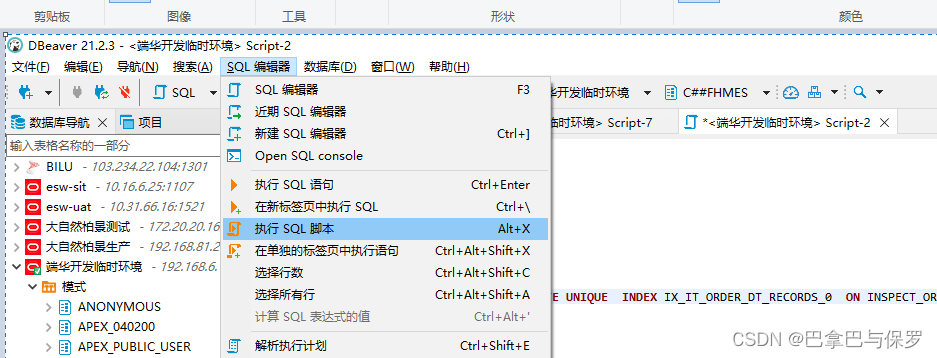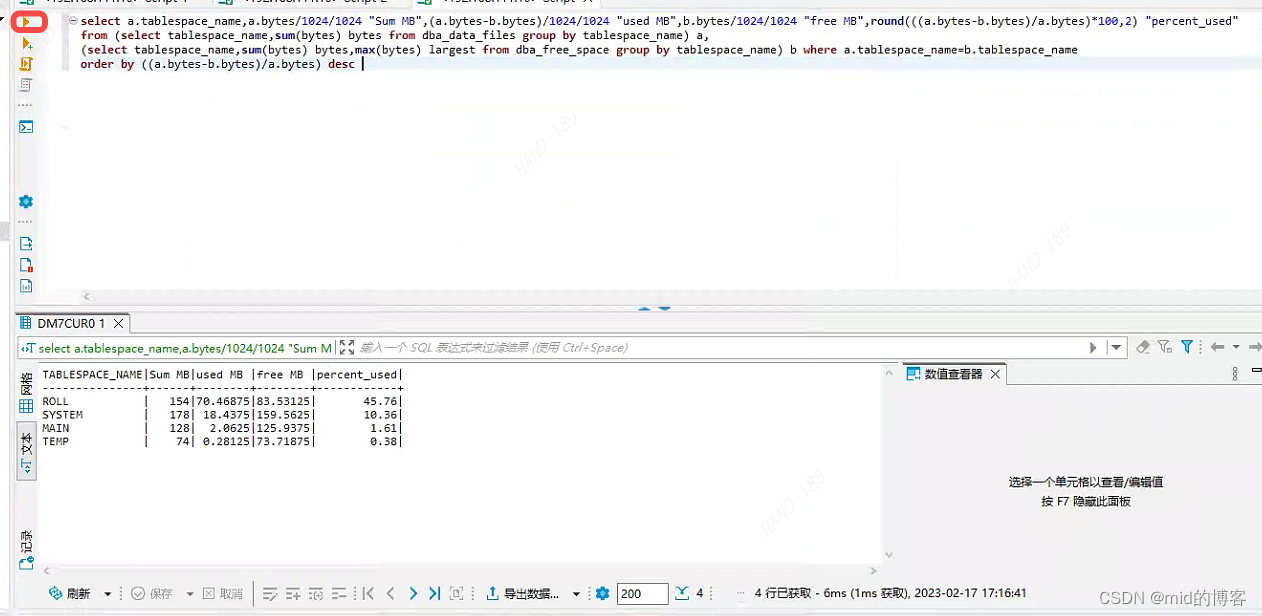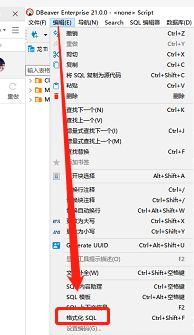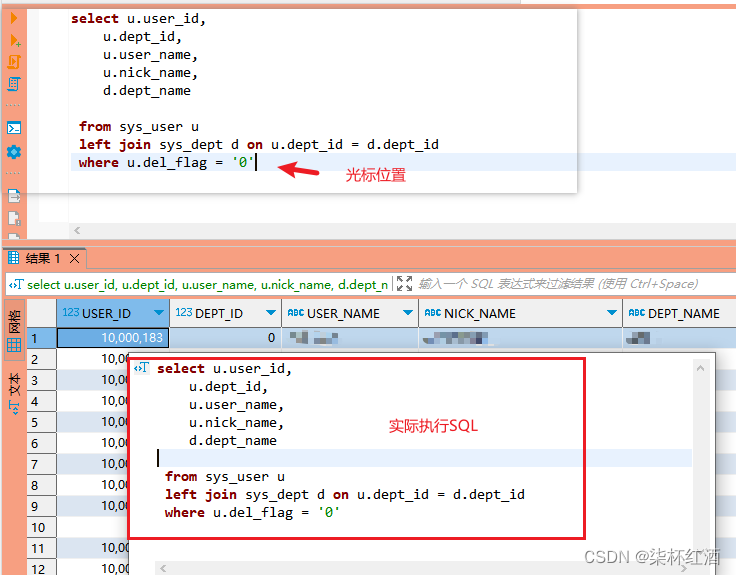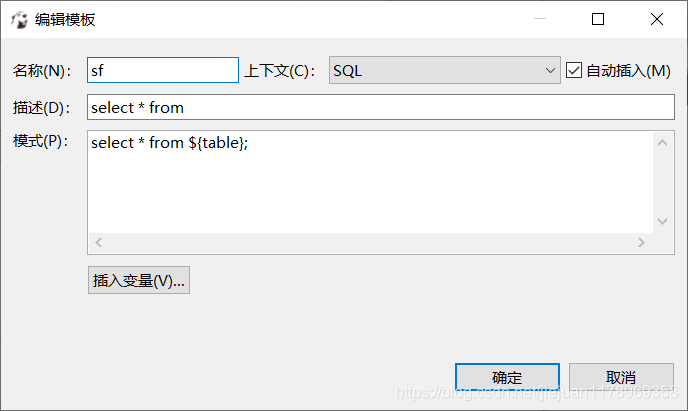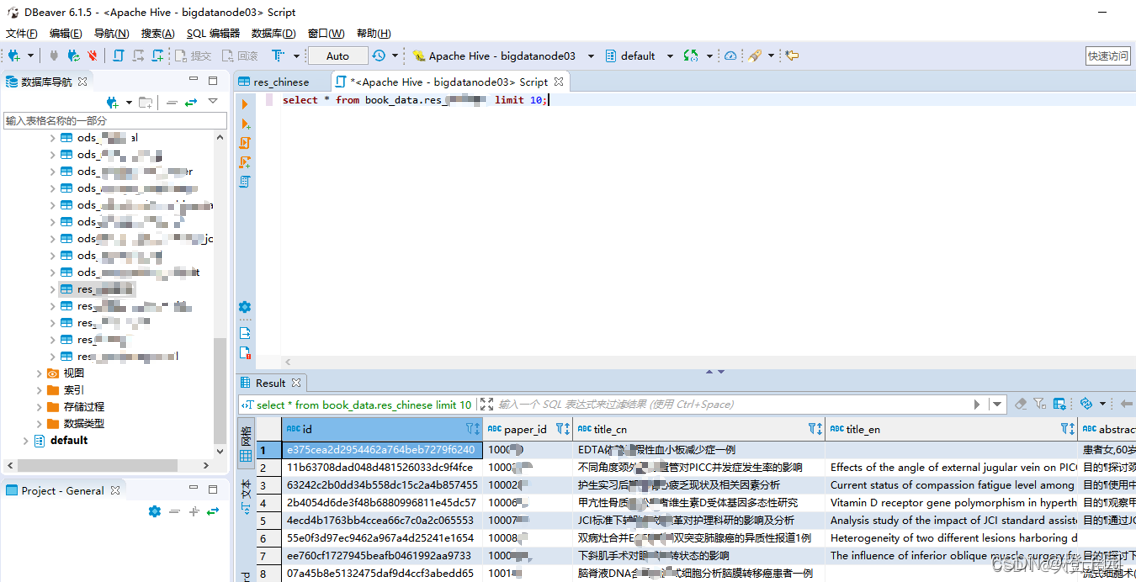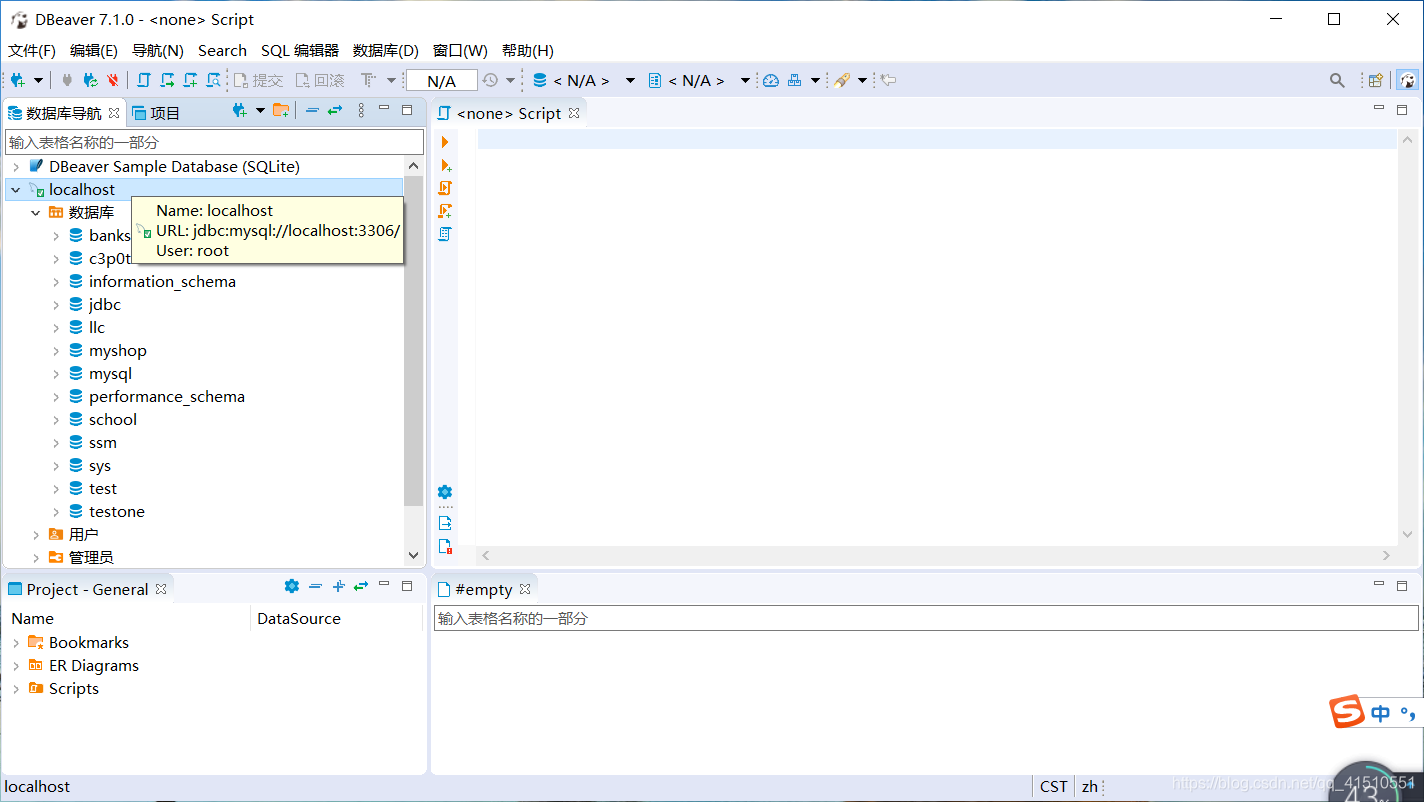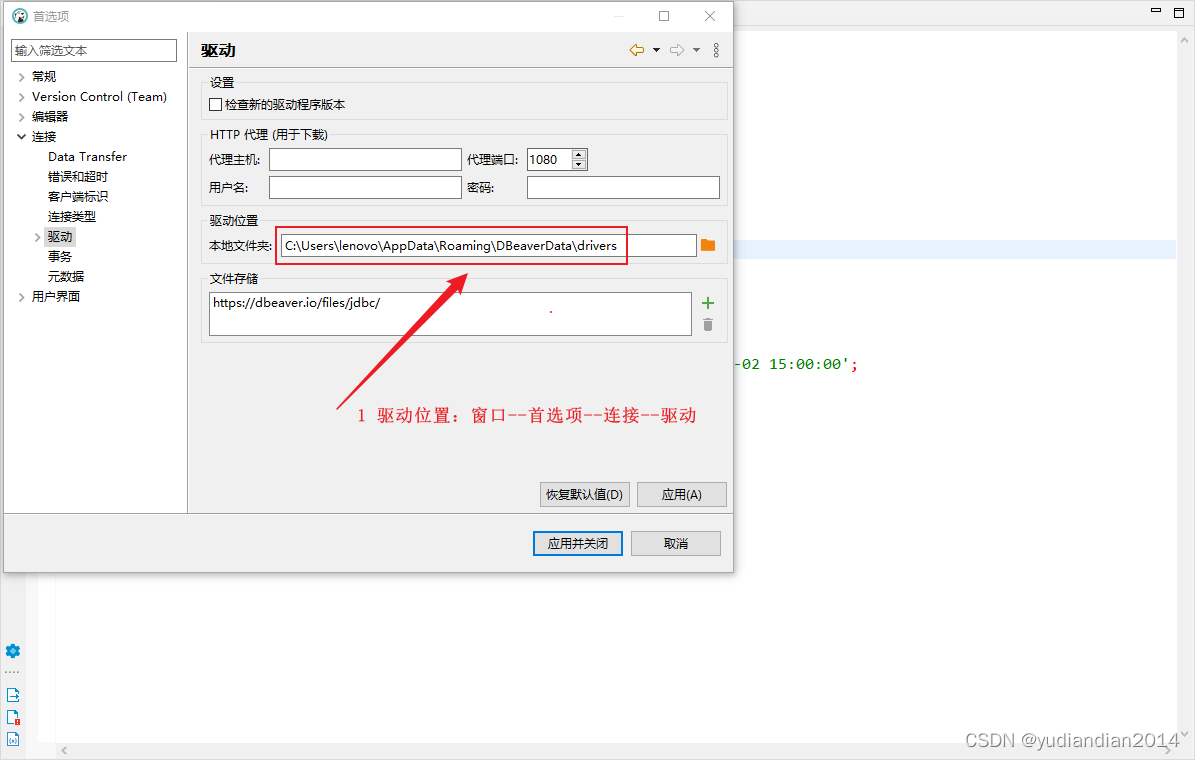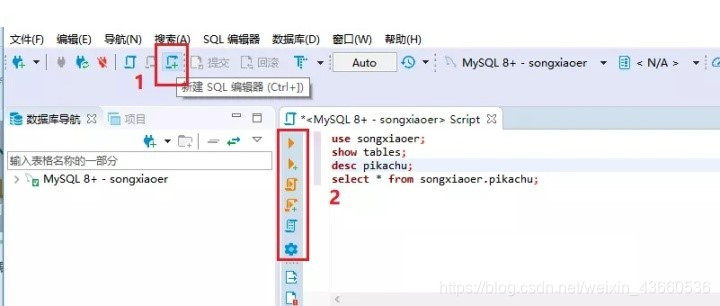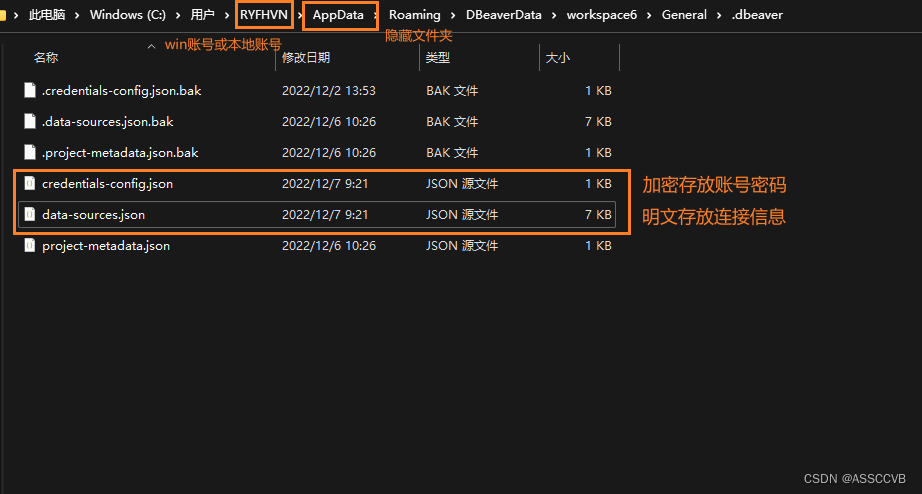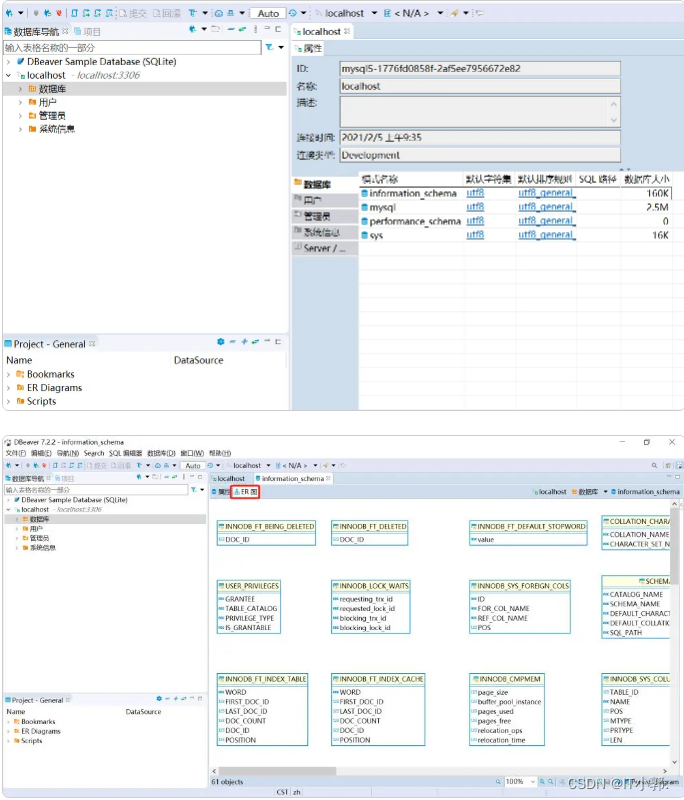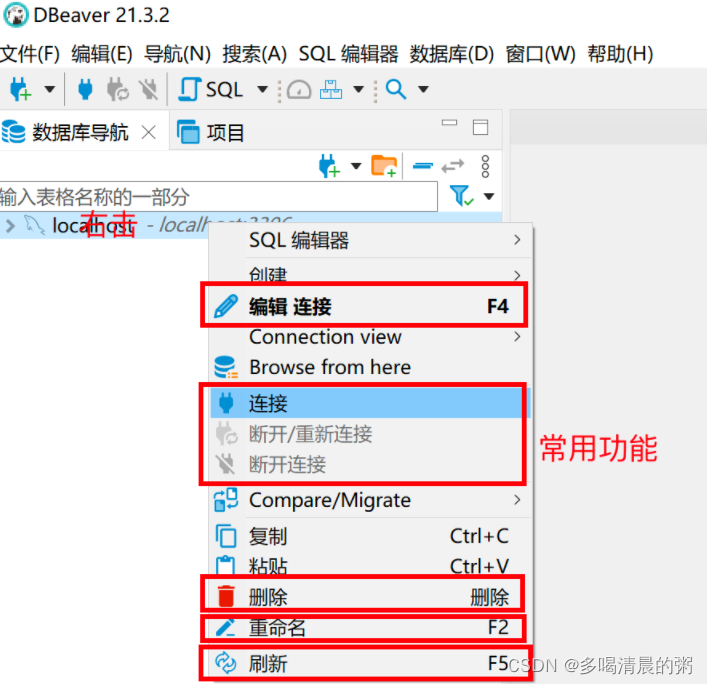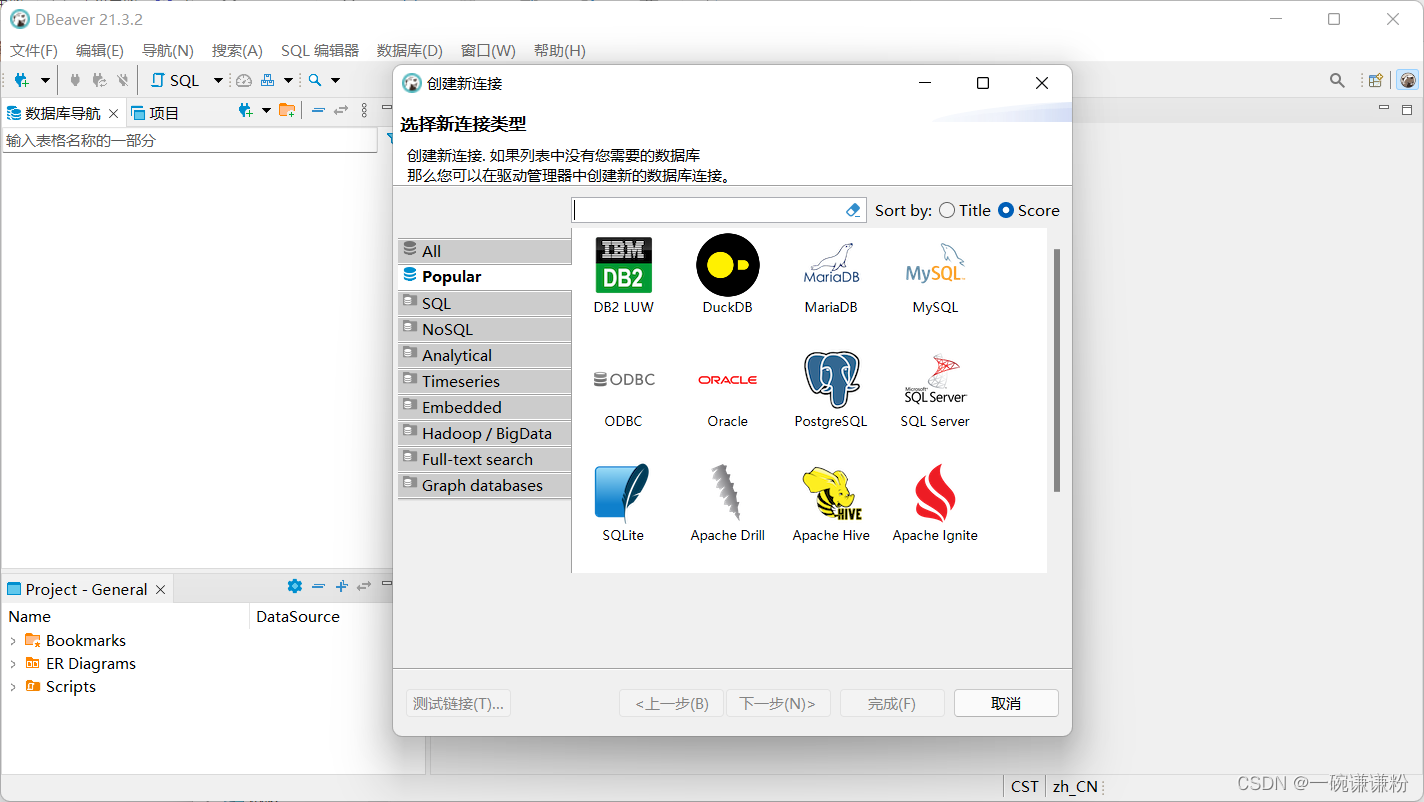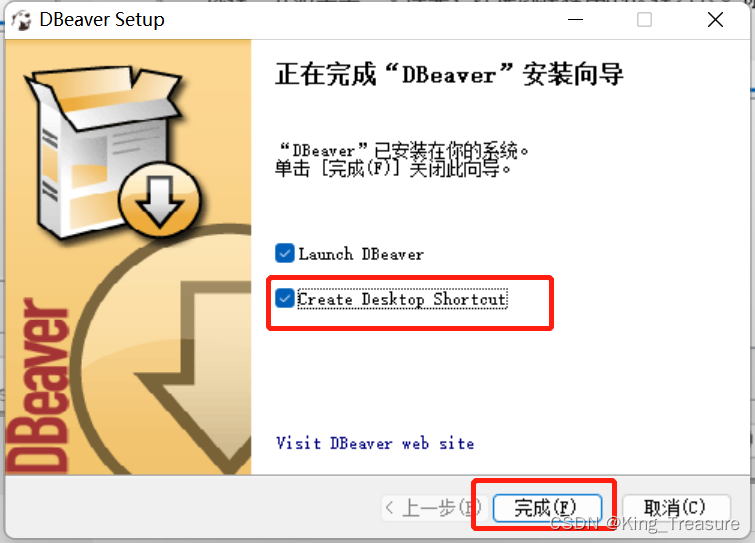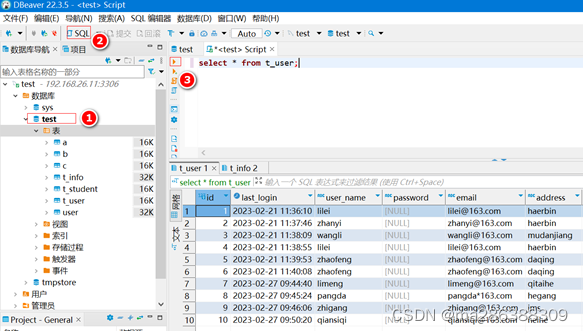JUC
1、什么是JUC
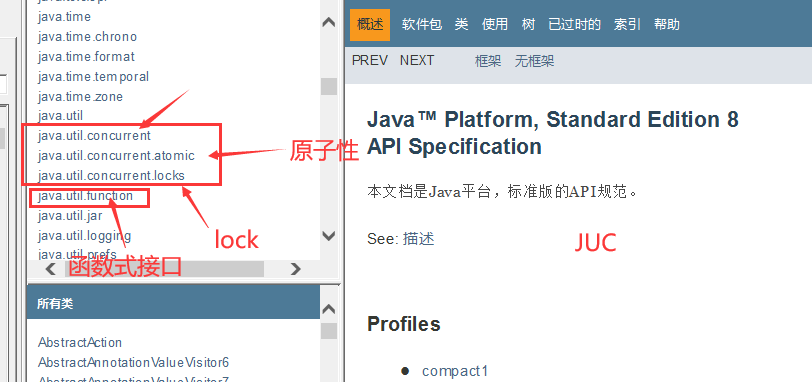
JUC:指的是java.util三个并发编程工具包
- java.util.concurrent
- java.util.concurrent.atomic
- java.util.concurrent.locks
实现多线程的四种方式:
- 继承Thread类
- 实现Runnable接口
- 实现Callable接口
- 线程池
业务:普通的线程代码 Thread
Runnable 没有返回值、效率相比于Callable相对较低!
Runnable接口和Callable接口区别:
- 是否有返回值:Runnable无返回值,Callable有返回值
- 是否抛出异常:call方法计算一个结果,如果不能这样做,就会抛出异常
- 实现方法名称不同,Runnable接口是run方法,Callable接口是call方法
2、线程和进程
进程:指在系统中正在运行的一个应用程序;程序一旦运行就是进程;进程——资源分配的最小单元。
线程:系统分配处理器时间资源的基本单元,或者说进程之内独立执行的一个单元执行流。线程——程序执行的最小单元。
进程:是一个程序,一个进程包含多个线程,且至少包含一个线程。
Java默认有两个线程:main 和 GC。
Java能开启线程吗? start方法开启线程
public synchronized void start() {/*** This method is not invoked for the main method thread or "system"* group threads created/set up by the VM. Any new functionality added* to this method in the future may have to also be added to the VM.** A zero status value corresponds to state "NEW".*/if (threadStatus != 0)throw new IllegalThreadStateException();/* Notify the group that this thread is about to be started* so that it can be added to the group's list of threads* and the group's unstarted count can be decremented. */group.add(this);boolean started = false;try {start0();started = true;} finally {try {if (!started) {group.threadStartFailed(this);}} catch (Throwable ignore) {/* do nothing. If start0 threw a Throwable thenit will be passed up the call stack */}}}//本地方法,底层C++,Java无法操作硬件,由操作系统决定是否创建线程,是否立即创建线程private native void start0();
Java是不能开启线程的,底层是调用start0()是一个native方法,由底层的C++方法编写。java无法直接操作硬件。
线程的几种状态
Thread.State
public enum State {NEW,//新建 RUNNABLE,//准备就绪 BLOCKED, //阻塞 WAITING,//一直等待TIMED_WAITING,//超时等待,过时不候TERMINATED;//终止}
wait/sleep区别
1.来自不同的类
wait => Object,任何对象实例都能调用
sleep => Thread,Thread的静态方法
2.关于锁的释放
wait会释放锁;sleep不会释放锁,它也不需要占用锁
3.使用范围、捕获异常不同
wait:必须在同步代码块中使用,不需要捕获异常
sleep:可以在任何地方使用,必须要捕获异常
并发、并行
并发编程:并发、并行
并发: 同一时刻多个线程访问同一个资源(多线程共享资源)
例如:春运抢票、电商秒杀
并行: 多项工作一起执行,之后再汇总
例如:泡方便面,电水壶烧水的同时,拆开泡面调料倒入桶中
System.out.println(Runtime.getRuntime().availableProcessors());//获取cpu的核数
并发编程的本质:充分利用CPU资源
管程
Monitor 监视器(就是平常说的锁)
是一种同步机制,保证同一时间内,只有一个线程访问被保护的数据或者代码
jvm同步基于进入和退出,使用管程对象实现的
用户线程和守护线程
用户线程:自定义线程(new Thread())
守护线程:后台中一种特殊的线程,比如垃圾回收
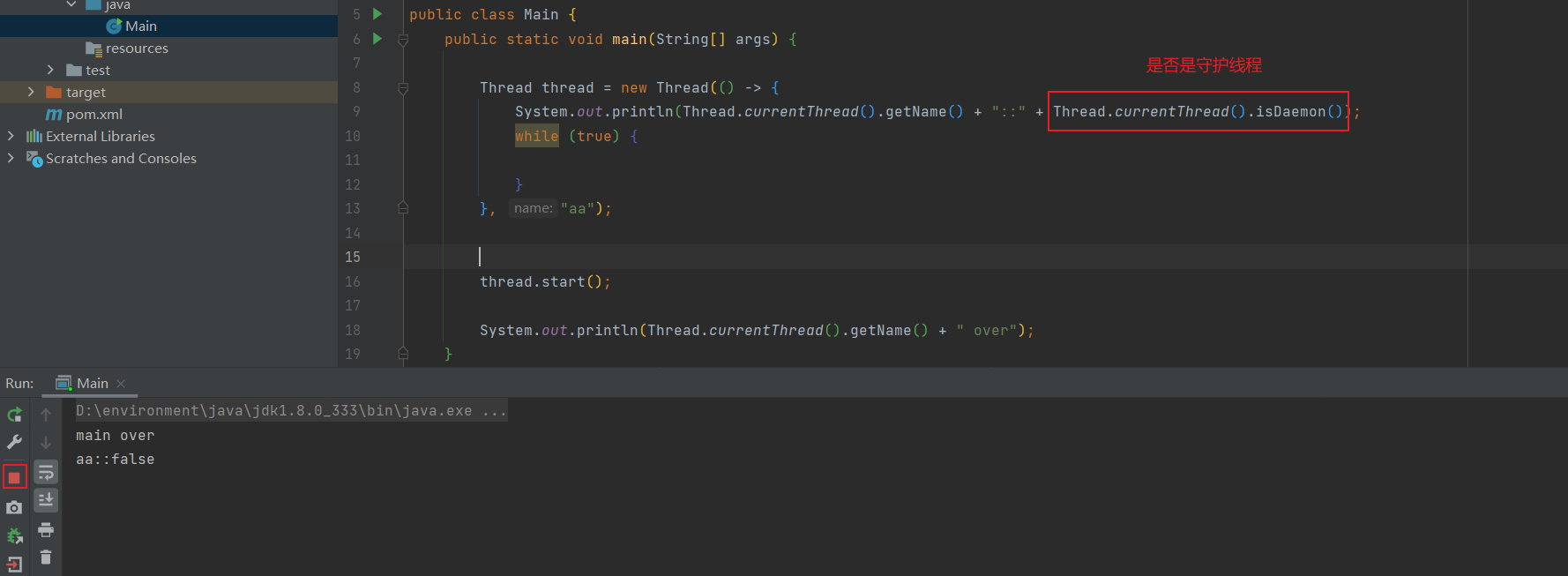
主线程结束了,用户线程还在运行,jvm存活
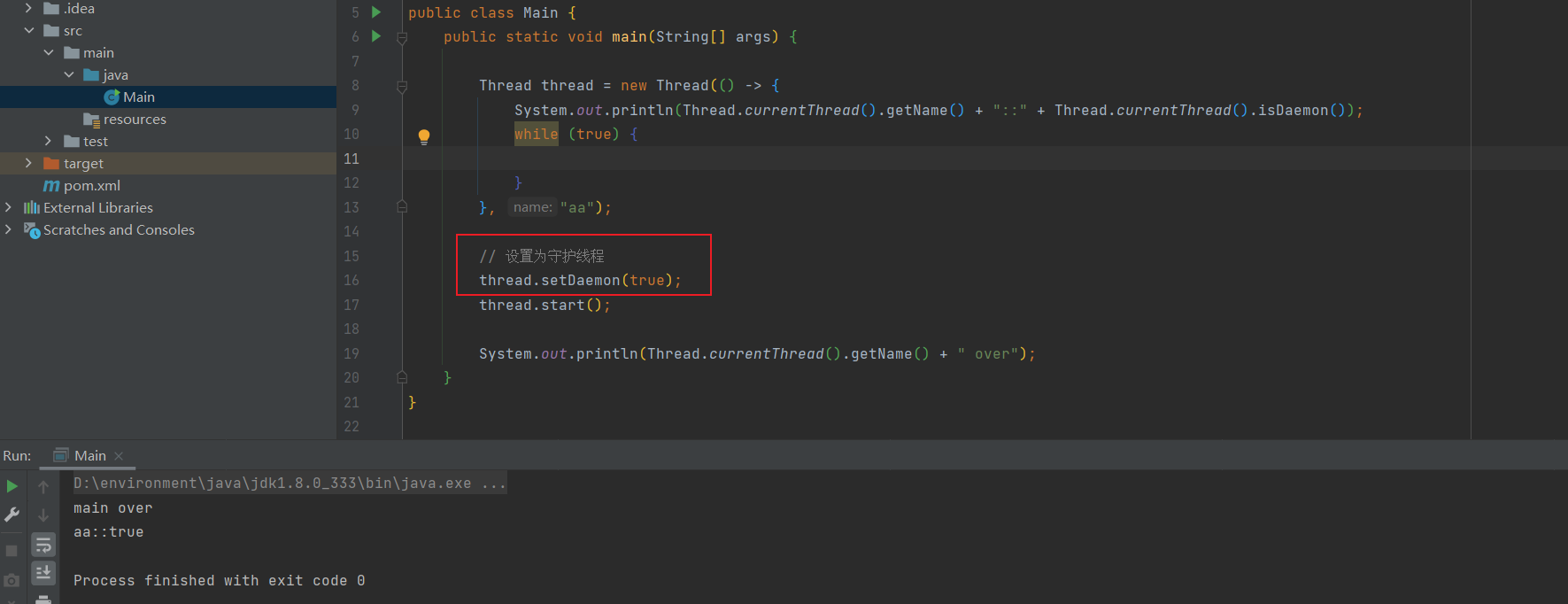
没有用户线程了,都是守护线程,jvm结束
3、Lock锁(重点)
多线程编程步骤:
- 创建资源类,在资源类创建属性和操作方法
- 创建多个线程,调用资源类的操作方法
案例:三个售票员同时卖30张票。
传统 synchronized
public class SaleTicketDemo1 {public static void main(String[] args) {//并发:多个线程操作同一个资源类,把资源类丢入线程Ticket ticket = new Ticket();//Runnable接口 -》 函数式接口,lambda表达式:函数式接口的实例new Thread(() -> {for (int i = 0; i < 30; i++) {ticket.sale();}},"A").start();new Thread(() -> {for (int i = 0; i < 30; i++) {ticket.sale();}},"B").start();new Thread(() -> {for (int i = 0; i < 30; i++) {ticket.sale();}},"C").start();}
}/*** 资源类*/
class Ticket {//属性private int num = 30;//synchronized 本质:线程串行化,排队,锁public synchronized void sale() {if (num > 0) {System.out.println(Thread.currentThread().getName() + "卖出了第" + (num--) + "张票,剩余" + num + "张");}}}
Lock接口

实现类


公平锁:十分公平,先来后到(阳光普照,效率相对低一些)
非公平锁:十分不公平,可以插队(默认,可能会造成线程饿死,但是效率高)
public class SaleTicketDemo2 {public static void main(String[] args) {//并发:多个线程操作同一个资源类,把资源类丢入线程Ticket2 ticket = new Ticket2();new Thread(() -> {for (int i = 0; i < 40; i++) ticket.sale();},"A").start();new Thread(() -> {for (int i = 0; i < 40; i++) ticket.sale();},"B").start();new Thread(() -> {for (int i = 0; i < 40; i++) ticket.sale();},"C").start();}
}/*** 资源类** Lock三部曲* 1.new ReentrantLock();* 2.lock.lock(); //加锁* 3.finally -》 lock.unlock();//解锁**/
class Ticket2 {//属性private int num = 30;// 创建可重入锁Lock lock = new ReentrantLock();public void sale() {lock.lock(); //加锁try {//业务代码if (num > 0) {System.out.println(Thread.currentThread().getName() + "卖出了第" + (num--) + "张票,剩余" + num + "张");}} finally {lock.unlock();//解锁}}}
synchronized 和 Lock区别
1.synchronized 是内置的Java关键字,Lock是Java的一个接口
2.synchronized 无法判断获取锁的状态,Lock可以判断是否获取到了锁
3.synchronized 会自动释放锁,Lock必须手动释放锁!如果不释放锁,会造成死锁
4.synchronized 线程一在获得锁的情况下阻塞了,第二个线程就只能傻傻的等着;Lock就不一定会等待下去
5.synchronized 可重入锁,不可以中断,非公平;Lock,可重入锁,可以判断锁,非公平/公平(可以自己设置,默认非公平锁)
6.synchronized 适合锁少量的同步代码;Lock适合锁大量同步代码!
7.Lock可以提高多个线程进行读操作的效率。
在性能上来说,如果竞争资源不激烈,两者性能是差不多的,而当竞争资源非常激烈时(即大量线程同时竞争),此时Lock的性能要远远优于synchronized
4、线程间通信
生产者和消费者问题
面试:单例模式、排序算法、生产者消费者问题、死锁
资源类操作步骤:判断等待 -》执行业务-》唤醒通知
生产者和消费者问题 synchronized 版
Object类中方法

/*** 线程之间通信问题:生产者和消费者问题! 等待唤醒,通知唤醒* 线程之间交替执行 A B 操作同一个变量 num = 0* A num+1* B num-1*/
public class ProducerAndConsumer {public static void main(String[] args) {Data data = new Data();new Thread(() -> {for (int i = 0; i < 10; i++) {try {data.increment();} catch (InterruptedException e) {e.printStackTrace();}}}, "A").start();new Thread(() -> {for (int i = 0; i < 10; i++) {try {data.decrement();} catch (InterruptedException e) {e.printStackTrace();}}}, "B").start();}
}/*** 资源类** 判断等待,业务,通知*/
class Data {private int num = 0;//+1public synchronized void increment() throws InterruptedException {if (num != 0) {//等待this.wait();}num++;System.out.println(Thread.currentThread().getName() + "=>" + num);//通知其他线程我+1 完毕了this.notifyAll();}//-1public synchronized void decrement() throws InterruptedException {if (num == 0) {//等待this.wait();}num--;System.out.println(Thread.currentThread().getName() + "=>" + num);//通知其他线程我-1 完毕了this.notifyAll();}
}

问题存在, A B C D 四个线程 虚假唤醒

public class ProducerAndConsumer {public static void main(String[] args) {Data data = new Data();new Thread(() -> {for (int i = 0; i < 10; i++) {try {data.increment();} catch (InterruptedException e) {e.printStackTrace();}}}, "A").start();new Thread(() -> {for (int i = 0; i < 10; i++) {try {data.decrement();} catch (InterruptedException e) {e.printStackTrace();}}}, "B").start();new Thread(() -> {for (int i = 0; i < 10; i++) {try {data.increment();} catch (InterruptedException e) {e.printStackTrace();}}}, "C").start();new Thread(() -> {for (int i = 0; i < 10; i++) {try {data.decrement();} catch (InterruptedException e) {e.printStackTrace();}}}, "D").start();}
}/*** 资源类* <p>* 判断等待,业务,通知*/
class Data {private int num = 0;/*** +1*/public synchronized void increment() throws InterruptedException {if (num != 0) {//等待this.wait();}num++;System.out.println(Thread.currentThread().getName() + "=>" + num);//通知其他线程我+1 完毕了this.notifyAll();}/*** -1*/public synchronized void decrement() throws InterruptedException {if (num == 0) {//等待this.wait();}num--;System.out.println(Thread.currentThread().getName() + "=>" + num);//通知其他线程我-1 完毕了this.notifyAll();}
}
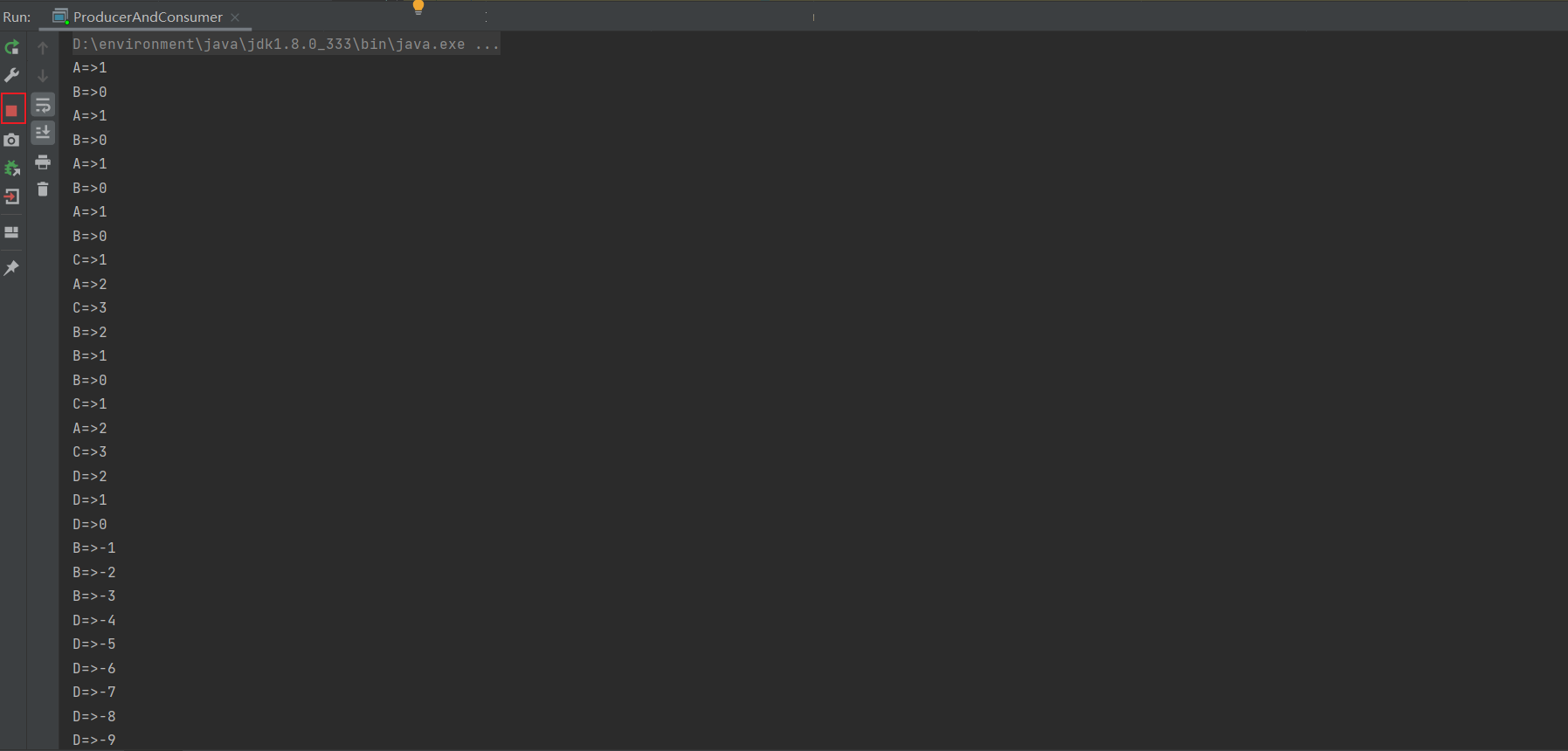
为什么会出现虚假唤醒问题呢?
主要是因为wait方法是从哪里等待就从哪里唤醒(而且wait是不会持有锁的,别的线程直接能拿到锁),if只会判断一次,只要第一次满足条件,等待唤醒就会直接执行下面+1/-1操作,所以才会出现>1或者<0的数甚至出现死锁现象,这些都是虚假唤醒导致的。
防止虚假唤醒问题:if 改为 while
/*** 线程之间通信问题:生产者和消费者问题! 等待唤醒,通知唤醒* 线程之间交替执行 A B 操作同一个变量 num = 0* A num+1* B num-1*/
public class ProducerAndConsumer {public static void main(String[] args) {Data data = new Data();new Thread(() -> {for (int i = 0; i < 10; i++) {try {data.increment();} catch (InterruptedException e) {e.printStackTrace();}}}, "A").start();new Thread(() -> {for (int i = 0; i < 10; i++) {try {data.decrement();} catch (InterruptedException e) {e.printStackTrace();}}}, "B").start();new Thread(() -> {for (int i = 0; i < 10; i++) {try {data.increment();} catch (InterruptedException e) {e.printStackTrace();}}}, "C").start();new Thread(() -> {for (int i = 0; i < 10; i++) {try {data.decrement();} catch (InterruptedException e) {e.printStackTrace();}}}, "D").start();}
}/*** 资源类** 判断等待,业务,通知*/
class Data {private int num = 0;//+1public synchronized void increment() throws InterruptedException {while (num != 0) {//等待this.wait();}num++;System.out.println(Thread.currentThread().getName() + "=>" + num);//通知其他线程我+1 完毕了this.notifyAll();}//-1public synchronized void decrement() throws InterruptedException {while (num == 0) {//等待this.wait();}num--;System.out.println(Thread.currentThread().getName() + "=>" + num);//通知其他线程我-1 完毕了this.notifyAll();}
}
JUC版的生产者和消费者问题
通过Lock找到Condition(官方文档)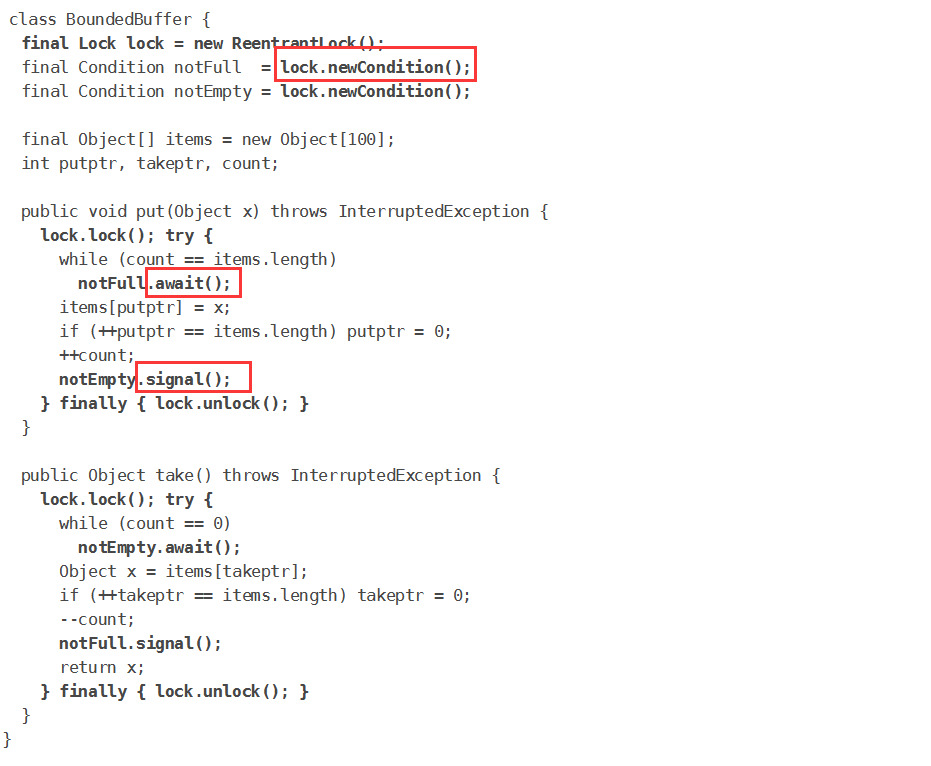
代码实现
public class ProducerAndConsumer2 {public static void main(String[] args) {Data2 data = new Data2();new Thread(() -> {for (int i = 0; i < 10; i++) {try {data.increment();} catch (InterruptedException e) {e.printStackTrace();}}}, "A").start();new Thread(() -> {for (int i = 0; i < 10; i++) {try {data.decrement();} catch (InterruptedException e) {e.printStackTrace();}}}, "B").start();new Thread(() -> {for (int i = 0; i < 10; i++) {try {data.increment();} catch (InterruptedException e) {e.printStackTrace();}}}, "C").start();new Thread(() -> {for (int i = 0; i < 10; i++) {try {data.decrement();} catch (InterruptedException e) {e.printStackTrace();}}}, "D").start();}
}/*** 资源类** 判断等待,业务,通知*/
class Data2 {private int num = 0;Lock lock = new ReentrantLock();Condition condition = lock.newCondition();//condition.await(); // 等待//condition.signalAll(); // 唤醒全部//+1public void increment() throws InterruptedException {lock.lock();try {//业务代码while (num != 0) {//等待condition.await();}num++;System.out.println(Thread.currentThread().getName() + "=>" + num);//通知其他线程我+1 完毕了condition.signalAll();} catch (Exception e) {e.printStackTrace();} finally {lock.unlock();}}//-1public void decrement() throws InterruptedException {lock.lock();try {while (num == 0) {//等待condition.await();}num--;System.out.println(Thread.currentThread().getName() + "=>" + num);//通知其他线程我-1 完毕了condition.signalAll();} catch (InterruptedException e) {e.printStackTrace();} finally {lock.unlock();}}
}
多线程编程完整步骤
第一步:创建资源类,在资源类中创建属性和操作方法
第二步:资源类操作方法
(1)判断等待
(2)业务逻辑
(3)通知唤醒
第三步:创建多个线程,调用资源类的操作方法
第四步:防止虚假唤醒
线程间定制通信
线程按约定顺序执行
任何一个新的技术,绝对不是仅仅只覆盖了原来的技术,有其优势和补充!
Condition精准的通知和唤醒线程
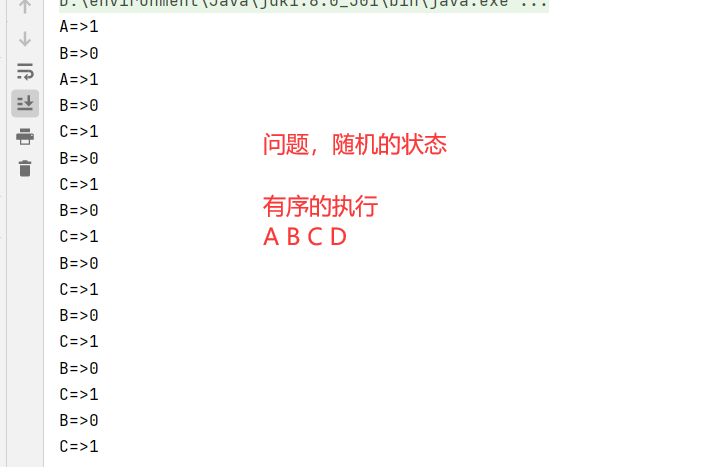
代码实现:三个线程顺序执行
/*** A B C三个线程顺序执行*/
public class C {public static void main(String[] args) {Resource resource = new Resource();new Thread(() -> {for (int i = 0; i < 10; i++) {resource.printA();}}, "A").start();new Thread(() -> {for (int i = 0; i < 10; i++) {resource.printB();}}, "B").start();new Thread(() -> {for (int i = 0; i < 10; i++) {resource.printC();}}, "C").start();}
}/*** 资源类 Lock*/
class Resource {private final Lock lock = new ReentrantLock();private final Condition condition1 = lock.newCondition();private final Condition condition2 = lock.newCondition();private final Condition condition3 = lock.newCondition();private int num = 1; // 1A 2B 3Cpublic void printA() {lock.lock();try {//业务 判断 -》 执行 -》 通知while (num != 1) {//等待condition1.await();}num = 2;System.out.println(Thread.currentThread().getName() + "=>AAA");//唤醒,唤醒指定线程Bcondition2.signal();} catch (Exception e) {e.printStackTrace();} finally {lock.unlock();}}public void printB() {lock.lock();try {//业务 判断 -》 执行 -》 通知while (num != 2) {condition2.await();}System.out.println(Thread.currentThread().getName() + "=>BBB");num = 3;//唤醒线程Ccondition3.signal();} catch (Exception e) {e.printStackTrace();} finally {lock.unlock();}}public void printC() {lock.lock();try {//业务 判断 -》 执行 -》 通知while (num != 3) {condition3.await();}System.out.println(Thread.currentThread().getName() + "=>CCC");num = 1;//唤醒线程Acondition1.signal();} catch (Exception e) {e.printStackTrace();} finally {lock.unlock();}}}
5、八锁现象
锁是什么?如何判断锁是谁?
任何类的对象、类对象
深刻理解锁
* 八锁,就是关于锁的八个问题* 1、标准情况下,两个线程先打印 发短信 还是 打电话? 1/发短信 2/打电话* 2、sendSms()延迟4s情况下,两个线程先打印 发短信 还是 打电话? 1/发短信 2/打电话*/
public class Test1 {public static void main(String[] args) {Phone phone = new Phone();//锁的存在new Thread(() -> {phone.sendSms();try {TimeUnit.SECONDS.sleep(1);} catch (InterruptedException e) {e.printStackTrace();}},"A").start();new Thread(() -> {phone.call();},"B").start();}
}class Phone{//synchronized 锁的对象是方法的调用者!//两个方法用的是同一把锁,谁先拿到谁执行!public synchronized void sendSms(){try {TimeUnit.SECONDS.sleep(4);} catch (InterruptedException e) {e.printStackTrace();}System.out.println("发短信");}public synchronized void call(){System.out.println("打电话");}
}
/*** 3、增加了一个普通方法后,先打印发短信还是hello? hello* 4、两个对象,两个同步方法 两个线程先打印 发短信 还是 打电话? 1/打电话 2/发短信*/
public class Test2{public static void main(String[] args) {//两个对象,两个不同的对象,两把锁!Phone2 phone1 = new Phone2();Phone2 phone2 = new Phone2();//锁的存在new Thread(() -> {phone1.sendSms();try {TimeUnit.SECONDS.sleep(1);} catch (InterruptedException e) {e.printStackTrace();}},"A").start();new Thread(() -> {phone2.call();},"B").start();}
}class Phone2{//synchronized 锁的对象是方法的调用者!//两个方法用的是同一把锁,谁先拿到谁执行!public synchronized void sendSms(){try {TimeUnit.SECONDS.sleep(4);} catch (InterruptedException e) {e.printStackTrace();}System.out.println("发短信");}public synchronized void call(){System.out.println("打电话");}//没有锁,不是同步方法,不受锁的影响public void hello(){System.out.println("hello");}
}
/*** 5.增加两个静态的同步方法 一个对象 两个线程先打印 发短信 还是 打电话? 1/发短信 2/打电话* 6.两个对象 两个静态的同步方法 两个线程先打印 发短信 还是 打电话? 1/发短信 2/打电话*/
public class Test3 {public static void main(String[] args) {//两个不同的对象 但是类只会加载一次 共用一把锁Phone3 phone1 = new Phone3();Phone3 phone2 = new Phone3();//锁的存在new Thread(() -> {phone1.sendSms();try {TimeUnit.SECONDS.sleep(1);} catch (InterruptedException e) {e.printStackTrace();}},"A").start();new Thread(() -> {phone2.call();},"B").start();}
}class Phone3{//static静态方法 锁的是类对象 Phone3.classpublic static synchronized void sendSms(){try {TimeUnit.SECONDS.sleep(4);} catch (InterruptedException e) {e.printStackTrace();}System.out.println("发短信");}public static synchronized void call(){System.out.println("打电话");}
}
/*** 7.一个静态同步方法一个普通同步方法 一个对象 两个线程先打印 发短信 还是 打电话? 打电话 发短信* 8.一个静态同步方法一个普通同步方法 两个对象 两个线程先打印 发短信 还是 打电话? 打电话 发短信*/
public class Test4 {public static void main(String[] args) {Phone4 phone1 = new Phone4();Phone4 phone2 = new Phone4();//锁的存在new Thread(() -> {phone1.sendSms();try {TimeUnit.SECONDS.sleep(1);} catch (InterruptedException e) {e.printStackTrace();}},"A").start();new Thread(() -> {phone2.call();},"B").start();}
}class Phone4{//static静态同步方法 锁的是类对象 Phone3.classpublic static synchronized void sendSms(){try {TimeUnit.SECONDS.sleep(4);} catch (InterruptedException e) {e.printStackTrace();}System.out.println("发短信");}//普通同步方法 锁的是方法调用者public synchronized void call(){System.out.println("打电话");}}
小结:
- 同步方法,谁先拿到锁谁先执行,同一把锁顺序执行。
- 普通同步方法锁的是 this 当前对象(即方法的调用者)。
- 静态同步方法锁的是类对象,类只会加载一次,所以静态同步方法永远锁的都是类对象(XXX.class)。
synchronized实现同步的基础:Java中的每一个对象都可以作为锁。
具体表现为一下3种形式。
- 对于普通同步方法,锁是当前实例对象。
- 对于静态同步方法,锁是当前类的Class对象。
- 对于同步方法块,锁是synchronized括号里配置的对象。
6、集合类不安全
List不安全
//java.util.ConcurrentModificationException 并发修改异常!
public class ListTest {public static void main(String[] args) {//并发下 ArrayList不安全/*解决方案1、List<String> list = new Vector<>();2、List<String> list = Collections.synchronizedList(new ArrayList<>());3、List<String> list = new CopyOnWriteArrayList<>();*///CopyOnWrite 写入时复制 COW 计算机程序设计领域的一种优化策略;//多个线程操作的时候 list 读取的时候 固定的 写入(覆盖)//再写入的时候避免覆盖,造成数据问题!//读写分离//CopyOnWriteArrayList 比 Vector 好在哪里?//Vector 底层是synchronized实现效率较低 ; CopyOnWriteArrayList 底层是ReentrantLock实现 效率更高 灵活性也更高List<String> list = new CopyOnWriteArrayList<>();for (int i = 0; i < 10; i++) {new Thread(() -> {list.add(UUID.randomUUID().toString().substring(0,5));System.out.println(list);}, String.valueOf(i)).start();}}
}
Set不安全
import java.util.Set;
import java.util.UUID;
import java.util.concurrent.CopyOnWriteArraySet;//java.util.ConcurrentModificationException
public class SetTest {public static void main(String[] args) {//HashSet<String> set = new HashSet<>();//解决方案一://Set<String> set = Collections.synchronizedSet(new HashSet<>());//解决方案二:Set<String> set = new CopyOnWriteArraySet<>();for (int i = 0; i < 30; i++) {new Thread(() -> {set.add(UUID.randomUUID().toString().substring(0,5));System.out.println(set);},String.valueOf(i)).start();}}
}
HashSet底层是什么?
HashSet底层是HashMap
public HashSet() {map = new HashMap<>();
}
// add() set 本质就是map 中的key, key是不可重复的!
public boolean add(E e) {return map.put(e, PRESENT)==null;
}// PRESENT 不变的值!
private static final Object PRESENT = new Object();
Map不安全
回顾HashMap底层

public class MapTest {public static void main(String[] args) {/*并发下 HashMap线程不安全解决方案:1.Map<String, Object> map = Collections.synchronizedMap(new HashMap<>());2.Map<String, Object> map = new ConcurrentHashMap<>();*///HashMap<String, Object> map = new HashMap<>();//Map<String, Object> map = Collections.synchronizedMap(new HashMap<>());Map<String, Object> map = new ConcurrentHashMap<>();//加载因子,初始容量for (int i = 0; i < 30; i++) {new Thread(() -> {map.put(Thread.currentThread().getName(), UUID.randomUUID().toString().substring(0,5));System.out.println(map);}, String.valueOf(i)).start();}}
}
7、Callable

1.可以有返回值
2.可以抛出异常
3.方法不同, run() -> call()
代码测试
public class CallableTest {public static void main(String[] args) throws ExecutionException, InterruptedException {new Thread(new MyThread()).start();/*本身Callable接口和Runnable接口毫无关系通过一个Runnable接口的实现类FutureTask,Callable接口与Runnable接口构建了关系,便可以启动线程*///适配类 FutureTask 是 Runnable接口的实现类 构造器 FutureTask(Callable<V> callable)MyThread1 t1 = new MyThread1();FutureTask<Integer> futureTask = new FutureTask<>(t1); //泛型是线程返回值类型/*启动两个线程,只会打印一个`call()...`*/new Thread(futureTask,"A").start(); //怎么启动Callablenew Thread(futureTask,"B").start(); //结果会被缓存,效率高Integer i = futureTask.get(); //获取线程返回值 get()可能会产生阻塞!把他放到最后 或者 使用异步通信来处理!System.out.println(i);}
}class MyThread implements Runnable{@Overridepublic void run() {}
}/*** 泛型是返回值类型*/
class MyThread1 implements Callable<Integer>{@Overridepublic Integer call(){System.out.println("call()...");//耗时的操作return 1024;}
}
注意:
1.有缓存
2.获取结果可能需要等待,会阻塞!
8、常用的辅助类(必会)
8.1 CountDownLatch(减法计数器)

/*** 计数器*/
public class CountDownLatchDemo {public static void main(String[] args) throws InterruptedException {//倒计时 起始为6 必须要执行任务的时候,再使用!CountDownLatch countDownLatch = new CountDownLatch(6);for (int i = 0; i < 6; i++) {new Thread(() -> {System.out.println(Thread.currentThread().getName() + "--->Go out");countDownLatch.countDown(); // -1}, String.valueOf(i)).start();}countDownLatch.await(); //等待计数器归零在向下执行System.out.println("Close Door!");}
}
原理:
countDownLatch.countDown(); // 数量-1
countDownLatch.await(); // 等待计数器归0,再向下执行
每次有线程调用 countDown() 数量-1,当计数器变为0,countDownLatch.await()就会被唤醒,继续往下执行!
8.2 CyclicBarrier(加法计数器)

public class CyclicBarrierDemo {public static void main(String[] args) {/*集齐7颗龙珠召唤神龙*///召唤神龙的线程CyclicBarrier barrier = new CyclicBarrier(7, () -> System.out.println("成功召唤神龙!"));for (int i = 1; i <= 7; i++) {final int temp = i;new Thread(() -> {System.out.println(Thread.currentThread().getName() + "收集了" + temp + "个龙珠");try {barrier.await(); //等待} catch (Exception e) {e.printStackTrace();}}).start();}}
}
8.3 Semaphore(信号量)
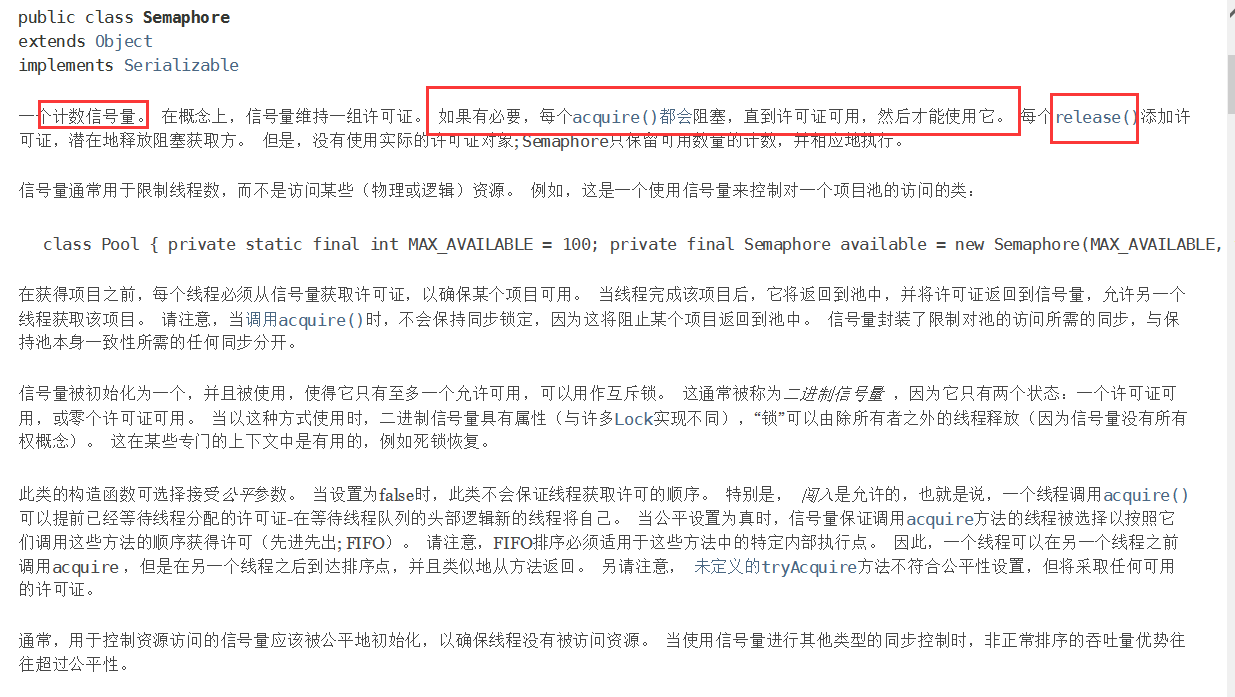
抢车位!
6车 - 3个停车位
public class SemaphoreDemo {public static void main(String[] args) {//线程数量:停车位! 限流!Semaphore semaphore = new Semaphore(3);for (int i = 1; i <= 6; i++) {new Thread(() -> {try {//acquire() 获得semaphore.acquire();System.out.println(Thread.currentThread().getName() + "抢到车位");TimeUnit.SECONDS.sleep(3);System.out.println(Thread.currentThread().getName() + "离开车位");} catch (InterruptedException e) {e.printStackTrace();} finally {semaphore.release(); //release() 释放}},String.valueOf(i)).start();}}
}
原理:
semaphore.acquire(); //获得,如果已经满了,等待,等待被释放为止!
semaphore.release(); // 释放,会将当前的信号量释放+1,然后唤醒等待的线程!
作用:多个共享资源互斥的使用!并发限流,控制最大的线程数!
9、读写锁
写锁:独占锁
读锁:共享锁
读写锁:一个资源可以被多个读线程访问,或者被一个写线程访问,但是不能同时存在读写线程,读写互斥,读读是共享的
ReadWriteLock
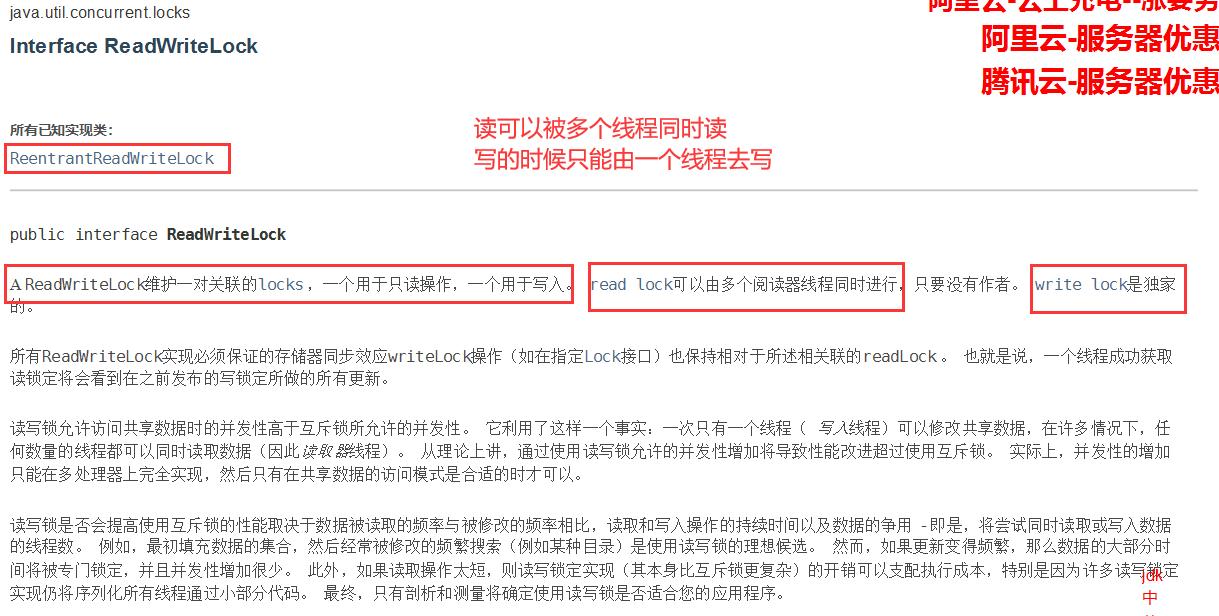
public class ReadWriteLockDemo {public static void main(String[] args) {MyCache myCache = new MyCache();for (int i = 1; i <= 5; i++) {final int temp = i;//写入new Thread(() -> {myCache.put(temp + "", temp + "");}, String.valueOf(i)).start();}for (int i = 1; i <= 5; i++) {final int temp = i;//读取new Thread(() -> {System.out.println("获取" + temp + "缓存数据-> " + myCache.get(temp + ""));}, String.valueOf(i)).start();}}
}/*** 自定义缓存*/
class MyCache {private volatile Map<String, Object> map = new HashMap<>();/*** 存 写*/public void put(String key, Object value) {System.out.println(Thread.currentThread().getName() + "写入" + key);try {TimeUnit.MILLISECONDS.sleep(200);} catch (InterruptedException e) {e.printStackTrace();}map.put(key, value);System.out.println(Thread.currentThread().getName() + "写入OK");}/*** 取 读*/public Object get(String key) {System.out.println(Thread.currentThread().getName() + "读取" + key);Object o = map.get(key);System.out.println(Thread.currentThread().getName() + "读取OK");return o;}
}
运行结果:
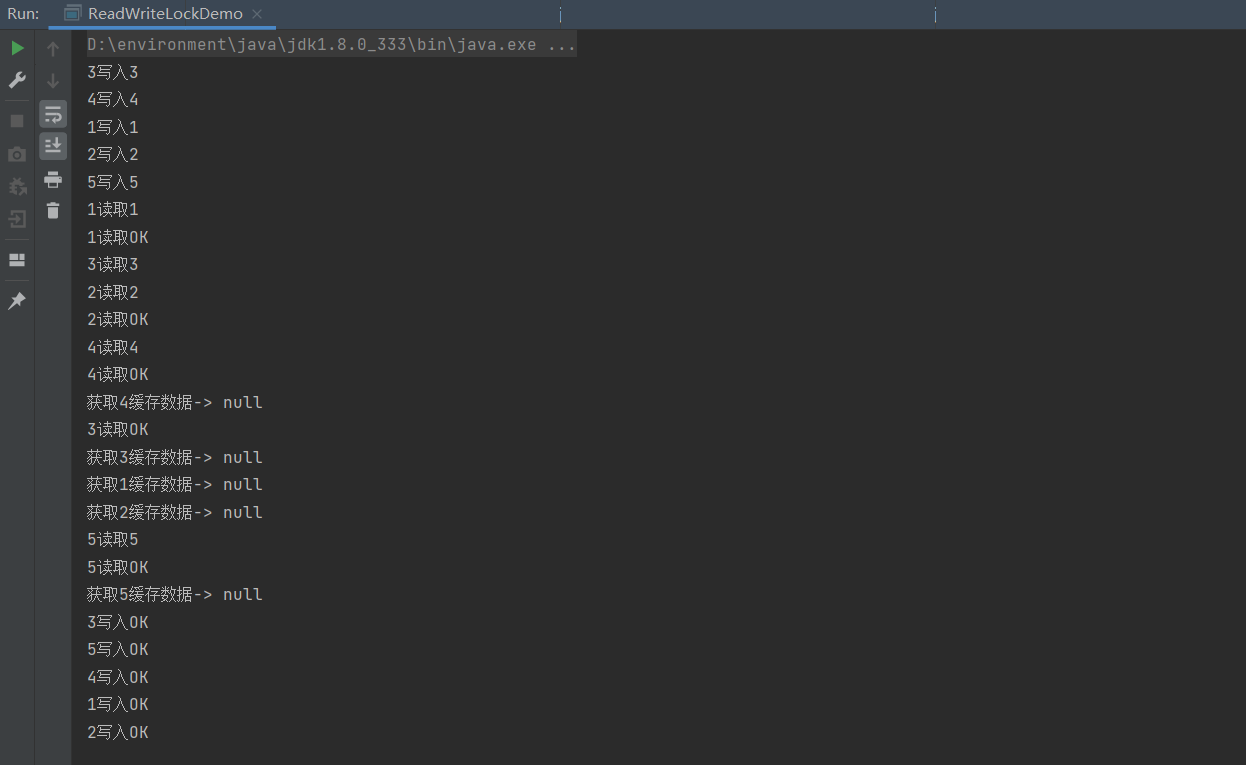
结果分析:由于是多线程操作,多个线程同时开启。写线程写入数据可能花费一些时间,此时数据还没写入完成,读线程就开始读数据导致读取不到任何数据,这种情况需要加锁控制。
加读写锁:
/*** 独占锁(写锁) 一次只能被一个线程占有* 共享锁(读锁) 多个线程可以同时占有* * ReadWriteLock* 读-读 可以共存!* 读-写 不可共存!* 写-写 不可共存!*/
public class ReadWriteLockDemo {public static void main(String[] args) {MyCache myCache = new MyCache();for (int i = 1; i <= 5; i++) {final int temp = i;//写入new Thread(() -> {myCache.put(temp + "", temp + "");}, String.valueOf(i)).start();}for (int i = 1; i <= 5; i++) {final int temp = i;//读取new Thread(() -> {System.out.println("获取" + temp + "缓存数据-> " + myCache.get(temp + ""));}, String.valueOf(i)).start();}}
}/*** 自定义缓存*/
class MyCache {private volatile Map<String, Object> map = new HashMap<>();private ReadWriteLock readWriteLock = new ReentrantReadWriteLock();/*** 存 写*/public void put(String key, Object value) {readWriteLock.writeLock().lock();System.out.println(Thread.currentThread().getName() + "写入" + key);try {TimeUnit.MILLISECONDS.sleep(200);map.put(key, value);} catch (InterruptedException e) {e.printStackTrace();} finally {readWriteLock.writeLock().unlock();}System.out.println(Thread.currentThread().getName() + "写入OK");}/*** 取 读*/public Object get(String key) {readWriteLock.readLock().lock();Object o = null;try {System.out.println(Thread.currentThread().getName() + "读取" + key);o = map.get(key);System.out.println(Thread.currentThread().getName() + "读取OK");} catch (Exception e) {e.printStackTrace();} finally {readWriteLock.readLock().unlock();}return o;}
}
此时结果是正确的
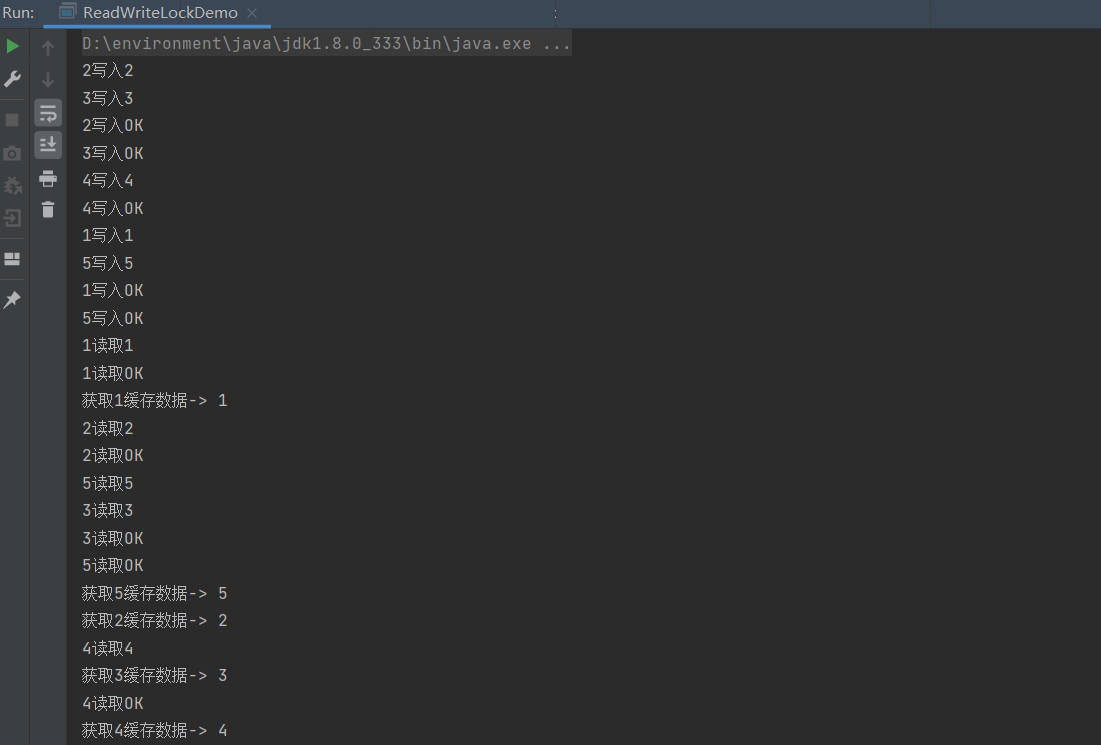
结果分析:由于加了读写锁,写锁是独占锁,读锁是共享锁。因此写的过程中不允许有任何操作,当写操作写完之后,可以多个线程共享读。
锁降级:写锁会降级为读锁,读锁不能升级为写锁。
10、阻塞队列
| BlockingQueue |
|---|
 |

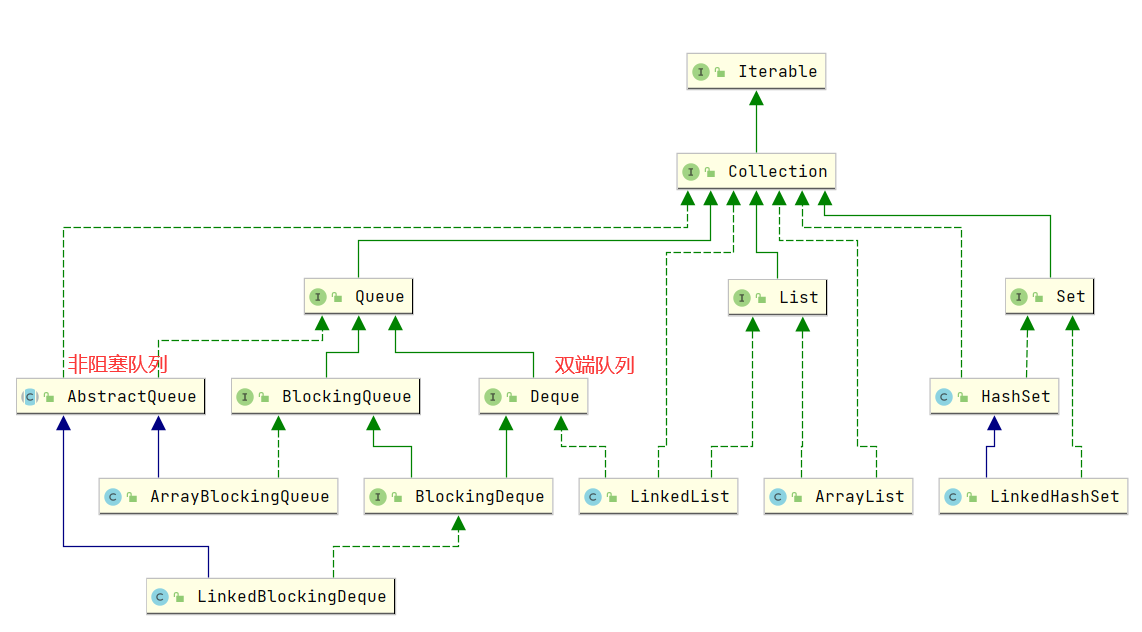
什么情况下我们会使用 阻塞队列:多线程并发处理,线程池!
学会使用队列
添加、移除
四组API
| 方式 | 抛出异常 | 不抛出异常 | 阻塞等待 | 超时等待 |
|---|---|---|---|---|
| 添加 | add() | offer() | put() | offer(E e, long timeout, TimeUnit unit) |
| 移除 | remove() | poll() | take() | poll(long timeout, TimeUnit unit) |
| 获取队首元素 | element() | peek() | - | - |
/*** 抛出异常*/public static void test1() {//队列的大小ArrayBlockingQueue<Object> arrayBlockingQueue = new ArrayBlockingQueue<>(3);System.out.println(arrayBlockingQueue.add("a"));System.out.println(arrayBlockingQueue.add("b"));System.out.println(arrayBlockingQueue.add("c"));//java.lang.IllegalStateException: Queue full 抛出异常//System.out.println(arrayBlockingQueue.add("d"));System.out.println("**************");System.out.println(arrayBlockingQueue.remove());System.out.println(arrayBlockingQueue.remove());System.out.println(arrayBlockingQueue.remove());//java.util.NoSuchElementException 抛出异常//System.out.println(arrayBlockingQueue.remove());}
/***有返回值,不抛出异常*/public static void test2(){ArrayBlockingQueue<Object> arrayBlockingQueue = new ArrayBlockingQueue<>(3);System.out.println(arrayBlockingQueue.offer("a"));System.out.println(arrayBlockingQueue.offer("b"));System.out.println(arrayBlockingQueue.offer("c"));//System.out.println(arrayBlockingQueue.offer("d")); // false 不抛出异常!System.out.println("*****");System.out.println(arrayBlockingQueue.poll());System.out.println(arrayBlockingQueue.poll());System.out.println(arrayBlockingQueue.poll());System.out.println(arrayBlockingQueue.poll()); // null 不抛出异常!}
/***等待,阻塞(一直阻塞)*/public static void test3() throws InterruptedException {ArrayBlockingQueue<Object> arrayBlockingQueue = new ArrayBlockingQueue<>(3);//一直阻塞arrayBlockingQueue.put("a");arrayBlockingQueue.put("b");arrayBlockingQueue.put("c");//arrayBlockingQueue.put("d"); //队列没有位置了,一直阻塞System.out.println(arrayBlockingQueue.take());System.out.println(arrayBlockingQueue.take());System.out.println(arrayBlockingQueue.take());System.out.println(arrayBlockingQueue.take()); //没有数据了,一直阻塞}
/***等待,阻塞(等待超时)*/public static void test4() throws InterruptedException {ArrayBlockingQueue<Object> arrayBlockingQueue = new ArrayBlockingQueue<>(3);arrayBlockingQueue.offer("a");arrayBlockingQueue.offer("b");arrayBlockingQueue.offer("c");arrayBlockingQueue.offer("d",2, TimeUnit.SECONDS); //等待两秒,超时退出System.out.println("******");System.out.println(arrayBlockingQueue.poll());System.out.println(arrayBlockingQueue.poll());System.out.println(arrayBlockingQueue.poll());arrayBlockingQueue.poll(2, TimeUnit.SECONDS); //等待两秒,超时退出}
SynchronousQueue 同步队列
进去一个元素,必须等待取出来之后,才能再往里面放一个元素!
put()、take()
/*** 同步队列* SynchronousQueue 和 BlockingQueue 不一样,SynchronousQueue 不存储元素* put一个元素,必须从里面take取出来,否则不能再put进去值!(存一个,取一个,循环)*/
public class SynchronousQueueDemo {public static void main(String[] args) {//存一个元素,取一个元素 循环SynchronousQueue<Object> synchronousQueue = new SynchronousQueue<>();new Thread(() -> {try {System.out.println(Thread.currentThread().getName() + "->put 1");synchronousQueue.put("1");System.out.println(Thread.currentThread().getName() + "->put 2");synchronousQueue.put("2");System.out.println(Thread.currentThread().getName() + "->put 3");synchronousQueue.put("3");} catch (InterruptedException e) {e.printStackTrace();}}, "T1").start();new Thread(() -> {try {TimeUnit.SECONDS.sleep(3);System.out.println(Thread.currentThread().getName() + "->take " + synchronousQueue.take());TimeUnit.SECONDS.sleep(3);System.out.println(Thread.currentThread().getName() + "->take " + synchronousQueue.take());TimeUnit.SECONDS.sleep(3);System.out.println(Thread.currentThread().getName() + "->take " + synchronousQueue.take());} catch (InterruptedException e) {e.printStackTrace();}}, "T2").start();}
}
11、线程池(重点)
线程池:三大方式、七大参数、四种拒绝策略
池化技术
程序运行,本质:占用系统资源!优化资源的使用!=> 池化技术
线程池、连接池、内存池、对象池…
创建、销毁,十分浪费资源。
池化技术:事先准备好一些资源,如果有人要用,就来我这里拿,用完之后还给我,以此来提高效率。
线程池的好处
1、降低资源的消耗;
2、提高响应的速度;
3、方便线程管理。
线程复用、可以控制最大并发数、管理线程

线程池:三大方法
/*** Executors 工具类:创建线程池 3大方法*/
public class Demo1 {public static void main(String[] args) {//ExecutorService threadPool = Executors.newSingleThreadExecutor();//创建单个线程的线程池//ExecutorService threadPool = Executors.newFixedThreadPool(5);//创建固定线程的线程池ExecutorService threadPool = Executors.newCachedThreadPool();//创建可伸缩线程池try {for (int i = 0; i < 10; i++) {//使用了线程池之后,用线程池来创建线程threadPool.execute(() -> {System.out.println(Thread.currentThread().getName() + " OK");});}} catch (Exception e) {e.printStackTrace();} finally {//线程池用完,程序结束,关闭线程池threadPool.shutdown();}}}
源码分析:七大参数
public static ExecutorService newSingleThreadExecutor() {return new FinalizableDelegatedExecutorService(new ThreadPoolExecutor(1, 1,0L, TimeUnit.MILLISECONDS,new LinkedBlockingQueue<Runnable>()));
}public static ExecutorService newFixedThreadPool(int nThreads) {return new ThreadPoolExecutor(nThreads, nThreads,0L, TimeUnit.MILLISECONDS,new LinkedBlockingQueue<Runnable>());
}public static ExecutorService newCachedThreadPool() {return new ThreadPoolExecutor(0, Integer.MAX_VALUE,60L, TimeUnit.SECONDS,new SynchronousQueue<Runnable>());
}//本质:ThreadPoolExecutor()public ThreadPoolExecutor(int corePoolSize, //核心线程池大小int maximumPoolSize, //最大核心线程池大小long keepAliveTime, //超时了没有人调用就会释放TimeUnit unit, //超时单位BlockingQueue<Runnable> workQueue, //阻塞队列ThreadFactory threadFactory, //线程工厂:创建线程,一般不用动RejectedExecutionHandler handler) { //拒绝策略if (corePoolSize < 0 ||maximumPoolSize <= 0 ||maximumPoolSize < corePoolSize ||keepAliveTime < 0)throw new IllegalArgumentException();if (workQueue == null || threadFactory == null || handler == null)throw new NullPointerException();this.acc = System.getSecurityManager() == null ?null :AccessController.getContext();this.corePoolSize = corePoolSize;this.maximumPoolSize = maximumPoolSize;this.workQueue = workQueue;this.keepAliveTime = unit.toNanos(keepAliveTime);this.threadFactory = threadFactory;this.handler = handler;}
手动创建一个线程池
/*** Executors 工具类:创建线程池 3大方法** 4大拒绝策略:* new ThreadPoolExecutor.AbortPolicy() //默认拒绝策略 银行满了,还有人进来,不处理这个人,抛出异常* new ThreadPoolExecutor.CallerRunsPolicy() //哪来的去哪里!* new ThreadPoolExecutor.DiscardPolicy() //队列满了,丢掉任务,不会抛出异常* new ThreadPoolExecutor.DiscardOldestPolicy() //队列满了,尝试和最早的竞争,也不会抛出异常!**/
public class Demo2 {public static void main(String[] args) {//工具类创建//ExecutorService threadPool = Executors.newSingleThreadExecutor();//创建单个线程的线程池//ExecutorService threadPool = Executors.newFixedThreadPool(5);//创建固定线程的线程池//ExecutorService threadPool = Executors.newCachedThreadPool();//创建可伸缩线程池//手动创建线程池 ThreadPoolExecutorExecutorService threadPool = new ThreadPoolExecutor(2,5,3,TimeUnit.SECONDS,new LinkedBlockingQueue<>(3),Executors.defaultThreadFactory(),new ThreadPoolExecutor.DiscardOldestPolicy()); //队列满了,尝试和最早的竞争,也不会抛出异常!try {//最大承载:Queue + max//超出最大承载抛出RejectedExecutionException 异常 (默认拒绝策略)for (int i = 0; i < 9; i++) {//使用了线程池之后,用线程池来创建线程threadPool.execute(() -> {System.out.println(Thread.currentThread().getName() + " OK");});}} catch (Exception e) {e.printStackTrace();} finally {//线程池用完,程序结束,关闭线程池threadPool.shutdown();}}}
四种拒绝策略

* 4大拒绝策略:* new ThreadPoolExecutor.AbortPolicy() //默认拒绝策略 银行满了,还有人进来,不处理这个人,抛出异常* new ThreadPoolExecutor.CallerRunsPolicy() //哪来的去哪里!* new ThreadPoolExecutor.DiscardPolicy() //队列满了,丢掉任务,不会抛出异常* new ThreadPoolExecutor.DiscardOldestPolicy() //队列满了,尝试和最早的竞争,也不会抛出异常!
小结与扩展
线程池最大线程数如何设置?
了解:IO密集型,CPU密集型(调优)
public class Demo1 {public static void main(String[] args) {//手动创建线程池 ThreadPoolExecutor//最大线程到底如何定义?//1、CPU 密集型 电脑处理器数是几,就是几,可以保证CPU的效率最高!//2、IO 密集型 大于 程序中十分耗IO的线程数 ---> 程序中 15个大型任务 io十分占用资源! =》 30//获取CPU核数 电脑处理器数System.out.println(Runtime.getRuntime().availableProcessors());ExecutorService threadPool = new ThreadPoolExecutor(2,Runtime.getRuntime().availableProcessors(),3,TimeUnit.SECONDS,new LinkedBlockingQueue<>(3),Executors.defaultThreadFactory(),new ThreadPoolExecutor.DiscardOldestPolicy()); //队列满了,尝试和最早的竞争,也不会抛出异常!try {//最大承载:Queue + max//超出最大承载 RejectedExecutionException (默认拒绝策略)for (int i = 0; i < 9; i++) {//使用了线程池之后,用线程池来创建线程threadPool.execute(() -> {System.out.println(Thread.currentThread().getName() + " OK");});}} catch (Exception e) {e.printStackTrace();} finally {//线程池用完,程序结束,关闭线程池threadPool.shutdown();}}}
12、四大函数式接口(必须掌握)

新时代程序员:lambda表达式(本质就是函数式接口的实例)、链式编程、函数式接口、Stream流式计算
函数式接口:只有一个抽象方法的接口
//此注解用来判断该接口是否是函数式接口
@FunctionalInterface
public interface Runnable {public abstract void run();
}//简化编程模型,在新版本的框架底层大量应用!
| Function函数型接口 |
|---|
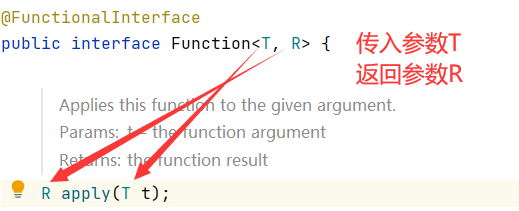 |
代码测试
/*** Function 函数型接口 有一个输入,有一个输出* 只要是 函数式接口 可以用 lambda表达式简化*/
public class Demo01 {public static void main(String[] args) {//输出输入的值
// Function<String ,String > fun = new Function<String ,String >() {
// @Override
// public String apply(String str) {
// return str;
// }
// };Function<String ,String > fun = (str) -> str; //lambda表达式System.out.println(fun.apply("123"));}
}
| Predicate断定型接口 |
|---|
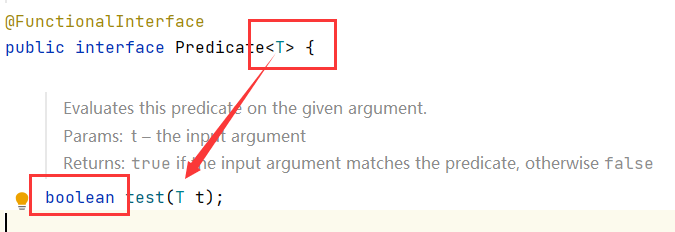 |
代码测试
/*** Predicate 断定型接口 有一个输入值 返回值是布尔值!*/
public class Demo02 {public static void main(String[] args) {//判断字符串是否为空
// Predicate<String> predicate = new Predicate<String>() {
// @Override
// public boolean test(String str) {
// return "".equals(str);
// }
// };Predicate<String> predicate = str -> "".equals(str);System.out.println(predicate.test(""));System.out.println(predicate.test("123"));}
}
| Consumer消费型接口 |
|---|
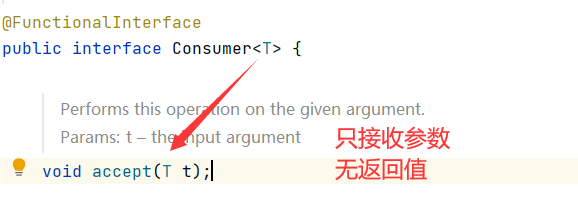 |
代码测试
/*** Consumer 消费型接口 只接收参数,不返回值*/
public class Demo03 {public static void main(String[] args) {//接收参数,将其打印出来
// Consumer<String> consumer = new Consumer<String>() {
// @Override
// public void accept(String str) {
// System.out.println(str);
// }
// };Consumer<String> consumer = str -> System.out.println(str);consumer.accept("hello");}
}
| Supplier供给型接口 |
|---|
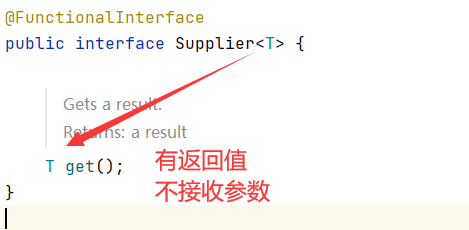 |
代码测试
/*** Supplier 供给型接口 不需参数,有返回值*/
public class Demo04 {public static void main(String[] args) {
// Supplier<String> supplier = new Supplier<String>() {
// @Override
// public String get() {
// return "world";
// }
// };Supplier<String> supplier = () -> "world";System.out.println(supplier.get());}
}
13、Stream流式计算
什么是Stream流式计算
大数据:存储 + 计算
存储:集合、MySQL
计算:流式计算~

public class Test {public static void main(String[] args) {User user1 = new User(1, "a", 21);User user2 = new User(2, "b", 22);User user3 = new User(3, "c", 23);User user4 = new User(4, "d", 24);User user5 = new User(5, "e", 25);User user6 = new User(6, "f", 26);//存储交给集合List<User> list = Arrays.asList(user1, user2, user3, user4, user5, user6);//计算交给Stream流//lambda表达式、链式编程、函数式接口、Stream流式计算list.stream().filter(user -> user.getId() % 2 == 0) //找出id为偶数的用户.filter(user -> user.getAge() > 23) //年龄大于23岁.map(user -> user.getName().toUpperCase()) //用户名 转为大写.sorted((u1, u2) -> -u1.compareTo(u2)) //用户名字母到着排序.limit(1) //只输出一个用户.forEach(System.out::println);}
}
14、ForkJoin
什么是ForkJoin
ForkJoin 在JDK1.7,并行执行任务!提高效率~。在大数据量速率会更快!
大数据中:MapReduce 核心思想->把大任务拆分为小任务!
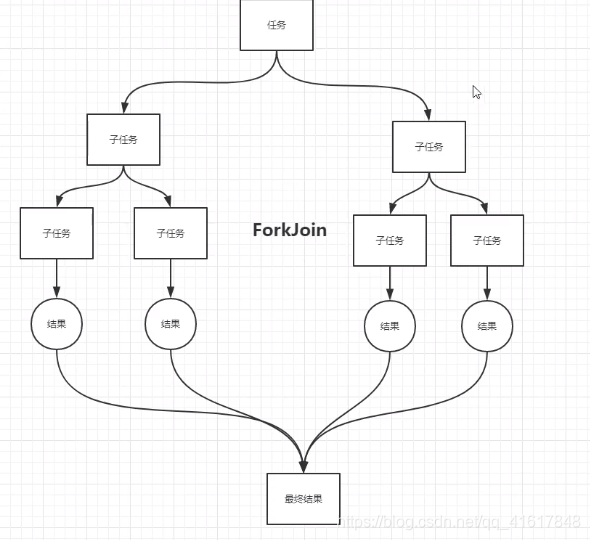
ForkJoin 特点: 工作窃取!
实现原理是:双端队列!从上面和下面都可以去拿到任务进行执行!(里面维护的都是双端队列)

Class ForkJoinPool的使用

ForkJoinTask
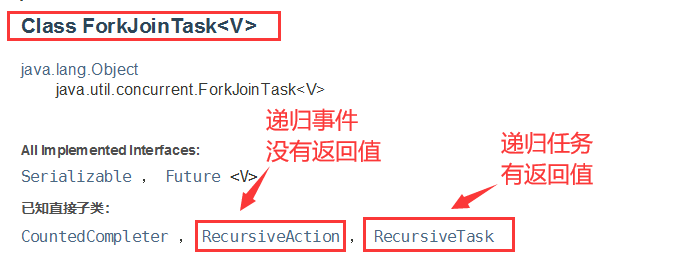
ForkJoin的计算类:
/*** 求和计算的任务** 如何使用 ForkJoin?* 1.ForkJoinPool 通过它来执行* 2.计算任务 forkJoinPool.execute(ForkJoinTask<?> task)* 3.计算类要继承ForkJoinTask*/
public class ForkJoinDemo extends RecursiveTask<Long> {private Long start;private Long end;//临界值private Long temp = 10000L;public ForkJoinDemo(Long start, Long end) {this.start = start;this.end = end;}//计算方法@Overrideprotected Long compute() {if ((end - start) < temp) {long sum = 0L;for (Long i = start; i <= end; i++) {sum += i;}return sum;} else {//分支合并计算Long middle = (start + end) / 2;//中间值ForkJoinDemo task1 = new ForkJoinDemo(start, middle);task1.fork(); //拆分任务,把线程任务压入线程队列ForkJoinDemo task2 = new ForkJoinDemo(middle, end);task2.fork(); //拆分任务,把线程任务压入线程队列//结果汇总return task1.join() + task2.join();}}
}
测试类:
/*** 三六九等 三 六(ForkJoin) 九(Stream并行流)*/
public class Test {public static void main(String[] args) throws ExecutionException, InterruptedException {//test1(); // 419//test2();test3();//234}//普通程序员public static void test1() {long sum = 0L;long start = System.currentTimeMillis();for (long i = 0L; i <= 10_0000_0000; i++) {sum += i;}long end = System.currentTimeMillis();System.out.println("sum = " + sum + " 时间:" + (end - start));}//会使用forkJoinpublic static void test2() throws ExecutionException, InterruptedException {long start = System.currentTimeMillis();ForkJoinPool forkJoinPool = new ForkJoinPool();ForkJoinTask<Long> task = new ForkJoinDemo(0L, 10_0000_0000L);ForkJoinTask<Long> submit = forkJoinPool.submit(task);//提交任务Long sum = submit.get();long end = System.currentTimeMillis();System.out.println("sum = " + sum + "时间:" + (end - start));}public static void test3() {long start = System.currentTimeMillis();//Stream并行流计算 []long sum = LongStream.rangeClosed(0L, 10_0000_0000L).parallel().reduce(0, Long::sum);long end = System.currentTimeMillis();System.out.println("sum = " + sum + " 时间:" + (end - start));}
}
.parallel().reduce(0, Long::sum) 使用一个并行流去计算,提高效率。(并行计算归约求和)
15、异步回调
Future 设计的初衷:对将来的某个事件结果进行建模!

线程异步调用通常使用CompletableFuture类
(1)没有返回值的runAsync异步回调
//没有返回值的 runAsync 异步回调CompletableFuture<Void> completableFuture = CompletableFuture.runAsync(()->{try {TimeUnit.SECONDS.sleep(2);} catch (InterruptedException e) {e.printStackTrace();}System.out.println(Thread.currentThread().getName() + " runAsync => Void");});System.out.println("11111");completableFuture.get(); //阻塞,获取执行结果
(2)有返回值的 supplyAsync 异步回调
/*** 类似异步调用:Ajax** 异步调用:CompletableFuture* 成功回调* 失败回调*/
public class Demo02 {public static void main(String[] args) throws ExecutionException, InterruptedException {//有返回值的 supplyAsync 异步回调//成功和失败回调//返回的是错误信息CompletableFuture<Integer> completableFuture = CompletableFuture.supplyAsync(() -> {System.out.println(Thread.currentThread().getName() + " supplyAsync => Integer");int i = 10 / 0;return 1024;});//成功回调System.out.println(completableFuture.whenComplete((t, u) -> {System.out.println("t=>" + t); //正常的返回结果System.out.println("u=>" + u); //错误信息 java.util.concurrent.CompletionException: java.lang.ArithmeticException: / by zero}).exceptionally((e -> {//失败回调System.out.println(e.getMessage());return 233; // 可以获取到错误的返回结果})).get());}
}
16、JMM
请你谈谈你对 volatile 的理解
volatile 是Java虚拟机提供轻量级的同步机制
1、保证可见性
2、不保证原子性
3、禁止指令重排
什么是JMM
JMM:Java内存模型,不存在的东西,概念!约定!
关于JMM的一些同步的约定:
线程中分为 工作内存、主内存
1、线程解锁前,必须把共享变量立刻刷回主存;
2、线程加锁前,必须读取主存中的最新值到工作内存中;
3、加锁和解锁是同一把锁
8种操作
- read(读取):作用于主内存变量,它把一个变量的值从主内存传输到线程的工作内存中,以便随后的load动作使用;
- load(载入):作用于工作内存的变量,它把read操作从主存中变量放入工作内存中;
- use(使用):作用于工作内存中的变量,它把工作内存中的变量传输给执行引擎,每当虚拟机遇到一个需要使用到变量的值,就会使用到这个指令;
- assign(赋值):作用于工作内存中的变量,它把一个从执行引擎中接受到的值放入工作内存的变量副本中;
- store(存储):作用于主内存中的变量,它把一个从工作内存中一个变量的值传送到主内存中,以便后续的write使用;
- write(写入):作用于主内存中的变量,它把store操作从工作内存中得到的变量的值放入主内存的变量中;
- lock(锁定):作用于主内存的变量,把一个变量标识为线程独占状态;
- unlock(解锁):作用于主内存的变量,它把一个处于锁定状态的变量释放出来,释放后的变量才可以被其他线程锁定;
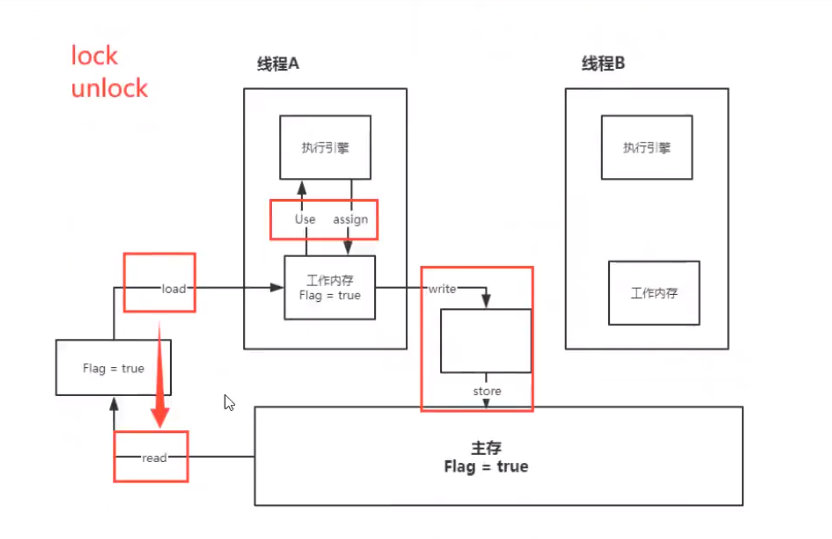
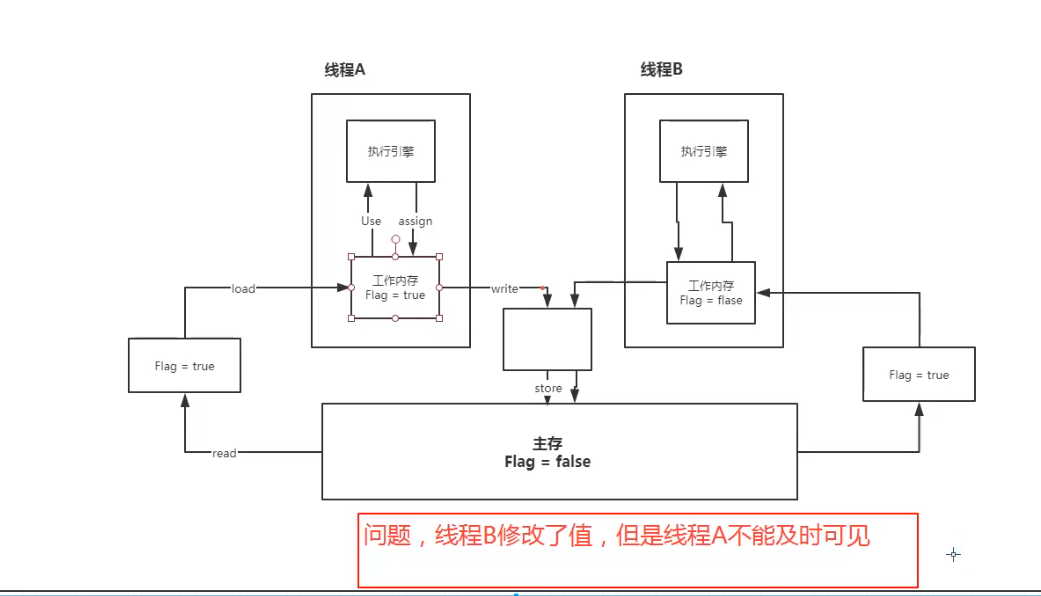
JMM对这8种操作给了相应的规定:
-
不允许read和load、store和write操作之一单独出现。即使用了read必须load,使用了store必须write
-
不允许线程丢弃他最近的assign操作,即工作变量的数据改变了之后,必须告知主存
-
不允许一个线程将没有assign的数据从工作内存同步回主内存
-
一个新的变量必须在主内存中诞生,不允许工作内存直接使用一个未被初始化的变量。就是对变量实施use、store操作之前,必须经过assign和load操作
-
一个变量同一时间只有一个线程能对其进行lock。多次lock后,必须执行相同次数的unlock才能解锁
-
如果对一个变量进行lock操作,会清空所有工作内存中此变量的值,在执行引擎使用这个变量前,必须重新load或assign操作初始化变量的值
-
如果一个变量没有被lock,就不能对其进行unlock操作。也不能unlock一个被其他线程锁住的变量
-
对一个变量进行unlock操作之前,必须把此变量同步回主内存
问题:程序A不知道主内存中的值发生了变化
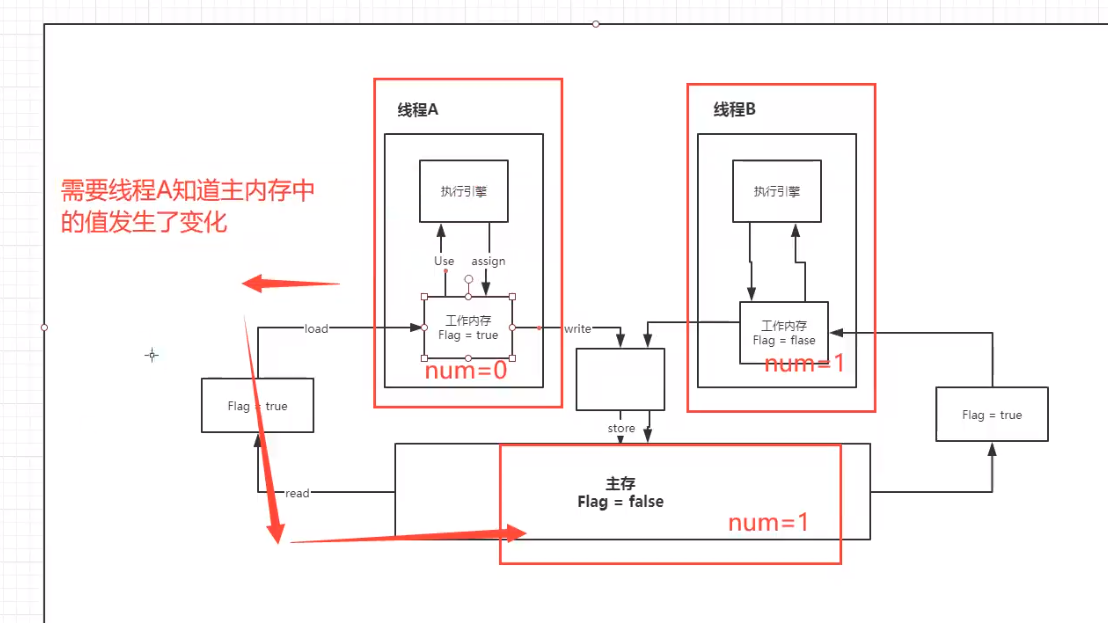
17、volatile
1)保证可见性
public class JMMDemo {// 如果不加volatile 程序会死循环// 加了volatile是可以保证可见性的,volatile保证一旦数据被修改,其它线程立马能够感知到private volatile static int num = 0;public static void main(String[] args) { // main 线程new Thread(()->{ // 线程1 不知道主内存中的值发生了变化while (num == 0){}}).start();try {TimeUnit.SECONDS.sleep(1);} catch (InterruptedException e) {e.printStackTrace();}num = 1;System.out.println(num);}
}
2)不保证原子性
原子性:不可分割
线程A在执行任务的时候,是不能被打扰的,也不能被分割的,要么同时成功,要么同时失败。
/*** 不保证原子性*/
public class VDemo2 {// volatile 不保证原子性private volatile static int num = 0;public static void add() {num++;}public static void main(String[] args) {// 20个线程,每个线程调用100次 理论值 2万for (int i = 0; i < 20; i++) {new Thread(() -> {for (int j = 0; j < 1000; j++) {add();}}).start();}while (Thread.activeCount() > 2) { // main gcThread.yield();}System.out.println(Thread.currentThread().getName() + " " + num);}
}
如果不加lock和synchronized ,怎么样保证原子性?
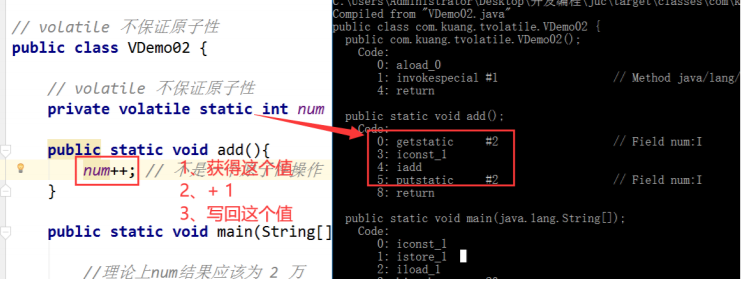
使用原子类,解决原子性问题
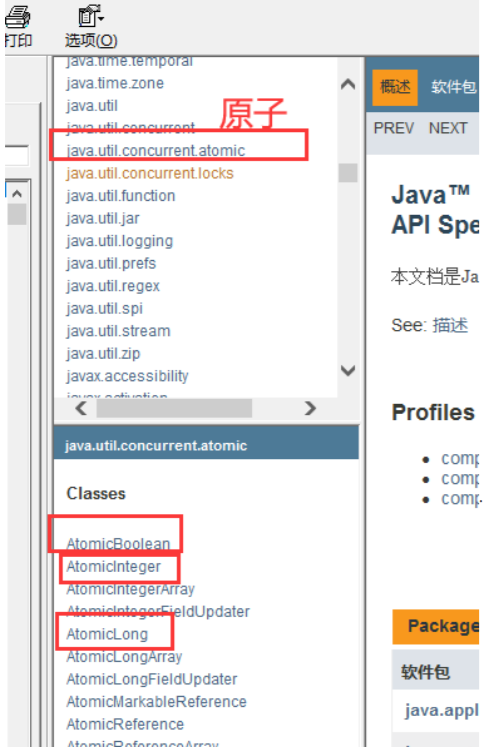
public class VDemo2 {// volatile 不保证原子性// 原子类的 Integerprivate volatile static AtomicInteger num = new AtomicInteger();public static void add() {//num++; //不是原子性操作num.getAndIncrement(); // +1 操作 底层是CAS保证的原子性}public static void main(String[] args) {// 20个线程,每个线程调用100次 理论值 2万for (int i = 0; i < 20; i++) {new Thread(() -> {for (int j = 0; j < 1000; j++) {add();}}).start();}while (Thread.activeCount() > 2) { // main gcThread.yield();}System.out.println(Thread.currentThread().getName() + " " + num);}
}
原子类的底层都直接和操作系统挂钩!在内存中修改值!
Unsafe类是一个很特殊的存在
3)禁止指令重排
指令重排
什么是指令重排?
我们写的程序,计算机并不是按照我们自己写的那样去执行的。
源代码–>编译器优化重排–>指令并行也可能会重排–>内存系统也会重排–>执行
处理器在进行指令重排的时候,会考虑数据之间的依赖性!
int x=1; //1
int y=2; //2
x=x+5; //3
y=x*x; //4//我们期望的执行顺序是 1234 可能执行的顺序会变成2134 1324
//可不可能是 4123? 不可能的
可能造成的影响结果:前提:a b x y这四个值 默认都是0
| 线程A | 线程B |
|---|---|
| x=a | y=b |
| b=1 | a=2 |
正常结果: x = 0; y =0;
| 线程A | 线程B |
|---|---|
| b=1 | a=2 |
| x=a | y=b |
可能造成的诡异结果:x = 2; y = 1;(概率极低)
volatile可以避免指令重排:
volatile中会加一道内存的屏障,这个内存屏障可以保证在这个屏障中的指令顺序。
内存屏障:CPU指令。作用:
1、保证特定的操作的执行顺序;
2、可以保证某些变量的内存可见性(利用这些特性,就可以保证volatile实现的可见性)
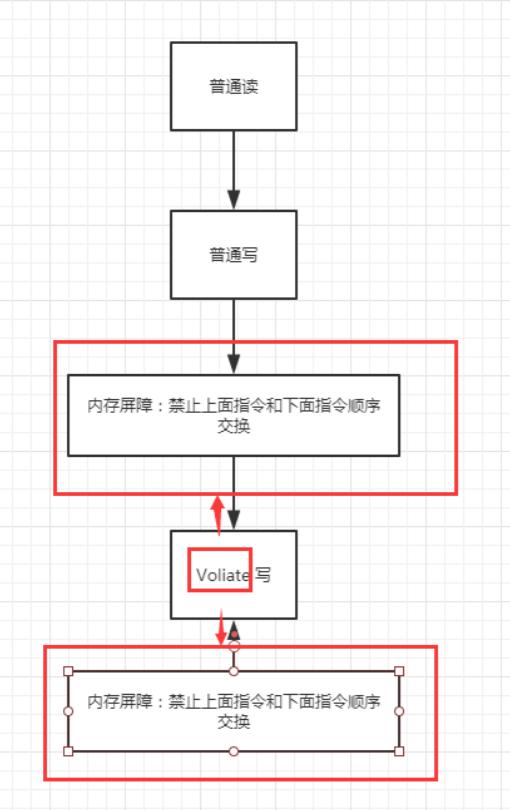
总结:
volatile 可以保证可见性;不能保证原子性;由于内存屏障,可以保证避免指令重排现像产生!
面试官:那么你知道在哪里用这个内存屏障用得最多呢?单例模式
18、彻底玩转单例模式
饿汉式、DCL懒汉式
1)饿汉式
/*** 饿汉式单例* 核心思想:构造器私有化*/
public class Hungry {// 可能浪费内存空间private byte[] data1 = new byte[1024*1024];private byte[] data2 = new byte[1024*1024];private byte[] data3 = new byte[1024*1024];private byte[] data4 = new byte[1024*1024];private static final Hungry HUNGRY = new Hungry();private Hungry(){}public static Hungry getInstance(){return HUNGRY;}
}
2)DCL懒汉式
/*** 懒汉式单例* 道高一尺,魔高一丈!*/
public class LazyMan {private volatile static LazyMan lazyMan;private static boolean flag = false;private LazyMan() {synchronized (LazyMan.class) {if (!flag) {flag = true;} else {throw new RuntimeException("不要试图使用反射破坏异常!");}}}//双重检测锁模式的 懒汉式单例 DCL懒汉式public static LazyMan getInstance() {if (null == lazyMan) {synchronized (LazyMan.class) {if (null == lazyMan) {lazyMan = new LazyMan(); // 不是一个原子性操作}}}return lazyMan;}//不加 synchronized 多线程情况下,不一定是单例public static void main(String[] args) throws Exception {
// for (int i = 0; i < 10; i++) {
// new Thread(() -> {
// LazyMan.getInstance();
// }).start();
// }//反射!//LazyMan instance = LazyMan.getInstance();Field flag = LazyMan.class.getDeclaredField("flag");flag.setAccessible(true);Constructor<LazyMan> constructor = LazyMan.class.getDeclaredConstructor(null);constructor.setAccessible(true);LazyMan instance = constructor.newInstance();flag.set(instance,false);LazyMan instance1 = constructor.newInstance();System.out.println(instance == instance1);}/*创建对象的步骤:1.分配内存空间2.执行构造方法,初始化对象3.把这个对象指向这个空间123132 线程A线程B // 此时lazyMan还没有完成构造*/
}
3)静态内部类
/*** 静态内部类*/
public class Holder {private Holder(){}public static class InnerClass{private static final Holder HOLDER = new Holder();}public static Holder getInstance(){return InnerClass.HOLDER;}
}
单例不安全, 因为反射
4)枚举类
/*** enum 是什么? 本身也是一个Class类*/
public enum EnumSingle {INSTANCE;public EnumSingle getInstance(){return INSTANCE;}
}class Test{public static void main(String[] args) throws Exception {EnumSingle instance1 = EnumSingle.INSTANCE;//EnumSingle instance2 = EnumSingle.INSTANCE;Constructor<EnumSingle> constructor = EnumSingle.class.getDeclaredConstructor(String.class,int.class);constructor.setAccessible(true);EnumSingle instance2 = constructor.newInstance(); //java.lang.NoSuchMethodException: com.lkl.singleton.EnumSingle.System.out.println(instance1);System.out.println(instance2);}
}
使用枚举,我们就可以防止反射破坏了

枚举类型的最终反编译源码:
public final class EnumSingle extends Enum
{public static EnumSingle[] values(){return (EnumSingle[])$VALUES.clone();}public static EnumSingle valueOf(String name){return (EnumSingle)Enum.valueOf(com/ogj/single/EnumSingle, name);}private EnumSingle(String s, int i){super(s, i);}public EnumSingle getInstance(){return INSTANCE;}public static final EnumSingle INSTANCE;private static final EnumSingle $VALUES[];static {INSTANCE = new EnumSingle("INSTANCE", 0);$VALUES = (new EnumSingle[] {INSTANCE});}
}
19、深入理解CAS
什么是CAS
大厂必须要研究底层!有所突破!修内功,基础不牢,地动山摇 操作系统、计算机网络原理
public class CASDemo {//CAS compareAndSet:比较并交换!public static void main(String[] args) {AtomicInteger atomicInteger = new AtomicInteger(2021);//期望、更新//public final boolean compareAndSet(int expect, int update)//如果我期望的值达到了,就更新,否则,就不更新,CAS 是CPU的并发原语!System.out.println(atomicInteger.compareAndSet(2021, 2022));System.out.println(atomicInteger.get());System.out.println(atomicInteger.compareAndSet(2021, 2022));System.out.println(atomicInteger.get());}
}
Unsafe类
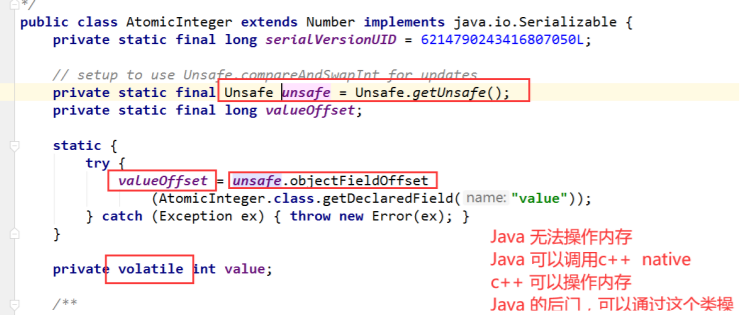
| atomicInteger.getAndIncrement(); |
|---|
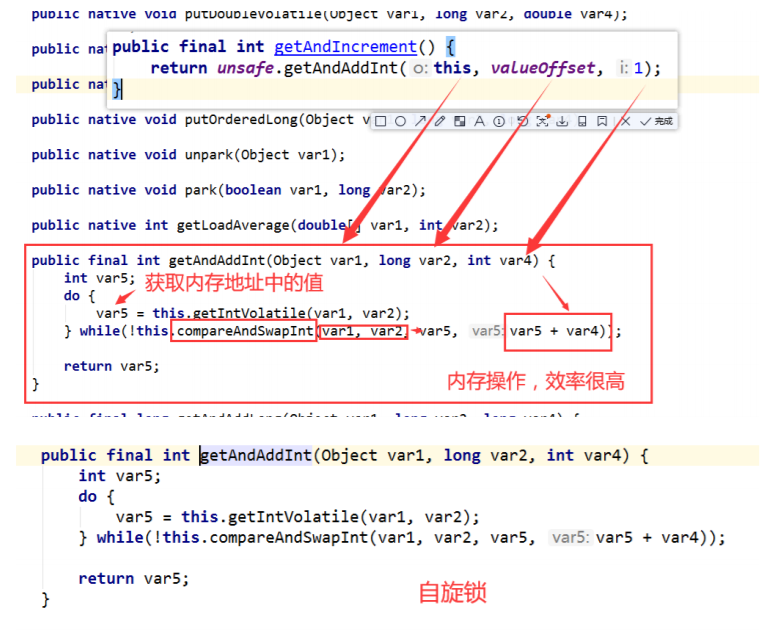 |
CAS:比较当前工作内存中的值和主内存中的值,如果这个值是期望的,那么执行操作!如果不是就一直循环,使用的是自旋锁。
缺点:
- 循环会耗时;
- 一次性只能保证一个共享变量的原子性;
- 它会存在ABA问题
CAS:ABA(狸猫换太子)
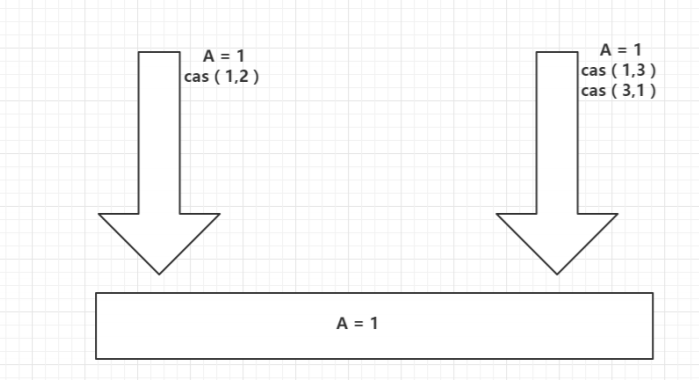
主内存中 A=1
线程1:期望值是1,要变成2;
线程2:两个操作:
- 期望值是1,变成3
- 期望是3,变成1
所以对于线程1来说,A的值还是1,所以就出现了问题,骗过了线程1;线程1不知道A的值发生了修改!
public class CASDemo2 {//CAS compareAndSet:比较并交换!public static void main(String[] args) {AtomicInteger atomicInteger = new AtomicInteger(2021);//期望、更新//public final boolean compareAndSet(int expect, int update)//如果我期望的值达到了,就更新,否则,就不更新,CAS 是CPU的并发原语!// ======================= 捣乱的线程 ==============================System.out.println(atomicInteger.compareAndSet(2021, 2022));System.out.println(atomicInteger.get());System.out.println(atomicInteger.compareAndSet(2022, 2021));System.out.println(atomicInteger.get());// ======================= 捣乱的线程 ==============================//======================== 期望的线程 ==============================System.out.println(atomicInteger.compareAndSet(2021, 6666));System.out.println(atomicInteger.get());}
}
20、原子引用(AtomicReference)
解决ABA问题,引入原子引用!对应的思想:乐观锁!
带版本号的原子操作!
public class CASDemo3 {//CAS compareAndSet:比较并交换!public static void main(String[] args) {//AtomicStampedReference 泛型如果使用包装类,注意对象引用问题//正常在业务操作,这里泛型都是一个个对象AtomicStampedReference<Integer> stampedReference = new AtomicStampedReference<>(1, 1);new Thread(() -> {int stamp = stampedReference.getStamp(); //获得版本号System.out.println(Thread.currentThread().getName() + " 1 -> " + stamp);try {TimeUnit.SECONDS.sleep(2);} catch (InterruptedException e) {e.printStackTrace();}System.out.println(stampedReference.compareAndSet(1, 2,stampedReference.getStamp(), stampedReference.getStamp() + 1));System.out.println(Thread.currentThread().getName() + " 2 -> " + stampedReference.getStamp());System.out.println(stampedReference.compareAndSet(2, 1,stampedReference.getStamp(), stampedReference.getStamp() + 1));System.out.println(Thread.currentThread().getName() + " 3 -> " + stampedReference.getStamp());}, "a").start();new Thread(() -> {int stamp = stampedReference.getStamp(); //获得版本号System.out.println(Thread.currentThread().getName() + " 1 -> " + stamp);try {TimeUnit.SECONDS.sleep(2);} catch (InterruptedException e) {e.printStackTrace();}System.out.println(stampedReference.compareAndSet(1, 6,stampedReference.getStamp(), stampedReference.getStamp() + 1));System.out.println(Thread.currentThread().getName() + " 2 -> " + stampedReference.getStamp());}, "b").start();try {TimeUnit.SECONDS.sleep(3);System.out.println("**************");System.out.println(stampedReference.getReference());} catch (InterruptedException e) {e.printStackTrace();}}
}
注意:
Integer 使用了对象缓存机制,默认范围是-128~127,推荐使用静态工厂方法valueOf获取对象实例,而不是new,因为valueOf使用缓存,而new一定会创建新的对象分配新的内存空间
| 整型包装类 |
|---|
 |
21、各种锁的理解
1、公平锁、非公平锁
公平锁:非常公平,不能插队,必须先来后到!(效率可能较低)
非公平锁:非常不公平,可以插队(默认都是非公平,效率较高)
public ReentrantLock() {sync = new NonfairSync();}
带参构造器,可以修改公平状态
public ReentrantLock(boolean fair) {sync = fair ? new FairSync() : new NonfairSync();}
2、可重入锁
可重入锁(递归锁):拿到外边的锁后,会自动拿到里面的锁(synchronized【隐式】和Lock【显式】都是可重入锁)

synchronized版
public class Demo01 {public static void main(String[] args) {Phone phone = new Phone();new Thread(()->{phone.sms();},"A").start();new Thread(()->{phone.sms();},"B").start();}
}class Phone{public synchronized void sms(){System.out.println(Thread.currentThread().getName() + " sms");call();}public synchronized void call(){System.out.println(Thread.currentThread().getName() + " call");}
}
Lock版
public class Demo02 {public static void main(String[] args) {Phone2 phone = new Phone2();new Thread(()->{phone.sms();},"A").start();new Thread(()->{phone.sms();},"B").start();}
}class Phone2{private final Lock lock = new ReentrantLock();public void sms(){lock.lock(); //Lock锁必须配对,有加锁就必须有解锁! 否则就会死锁!try {System.out.println(Thread.currentThread().getName() + " sms");call();} finally {lock.unlock();}}public void call(){lock.lock();try {System.out.println(Thread.currentThread().getName() + " call");} finally {lock.unlock();}}
}
3、自旋锁
spinlock

自定义自旋锁:
public class spinlock {// int 0// Thread nullAtomicReference<Thread> atomicReference = new AtomicReference<>();//加锁public void myLock(){Thread thread = Thread.currentThread();System.out.println(Thread.currentThread().getName() + " ==> myLock");//自旋锁while (!atomicReference.compareAndSet(null,thread)){}}//解锁public void myUnLock(){Thread thread = Thread.currentThread();System.out.println(Thread.currentThread().getName() + " ==> myUnLock");atomicReference.compareAndSet(thread,null);}
}
测试自定义自旋锁:
public class TestSpinLock {public static void main(String[] args) {
// Lock lock = new ReentrantLock();
// lock.lock();
// lock.unlock();// 底层使用的自旋锁CASspinlock spinlock = new spinlock();new Thread(() -> {spinlock.myLock();try {TimeUnit.SECONDS.sleep(4);} catch (Exception e) {e.printStackTrace();} finally {spinlock.myUnLock();}}, "T1").start();new Thread(() -> {spinlock.myLock();try {TimeUnit.SECONDS.sleep(3);} catch (Exception e) {e.printStackTrace();} finally {spinlock.myUnLock();}}, "T2").start();}
}
| 输出结果 |
|---|
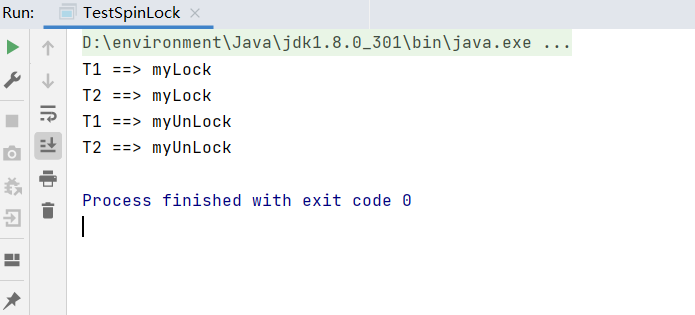 |
结果分析:
两个线程共同操作一把锁,谁先拿到锁谁先执行。T1线程先拿到锁加锁,其次是T2线程,先输入第一行再输出第二行;T1线程4s后释放锁,随之T2线程拿到锁加锁进行操作,3s后释放锁。故:先输入第一二行,4s后输出第三行,3s后输出第四行。
4、死锁
什么是死锁?两个或者两个以上进程在执行过程中,因为争夺资源而造成一种互相等待的现象,如果没有外力干涉,他们无法在执行下去。
两个线程拿着自己锁不放的同时,试图获取对方的锁,就会造成死锁。
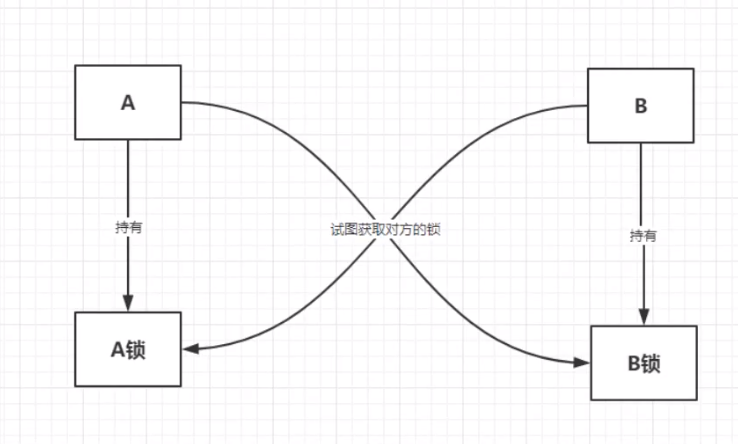
死锁测试,怎么排除死锁!
/*** 死锁样例*/
public class DeadLockDemo {static Object a = new Object();static Object b = new Object();public static void main(String[] args) {new Thread(() -> {synchronized (a) {System.out.println(Thread.currentThread().getName() + " 获取到锁a,试图获取锁b");try {TimeUnit.SECONDS.sleep(1);} catch (InterruptedException e) {e.printStackTrace();}synchronized (b) {System.out.println("获取到锁b");}}}, "A").start();new Thread(() -> {synchronized (b) {System.out.println(Thread.currentThread().getName() + " 获取到锁b,试图获取锁a");try {TimeUnit.SECONDS.sleep(1);} catch (InterruptedException e) {e.printStackTrace();}synchronized (a) {System.out.println("获取到锁a");}}}, "B").start();}
}
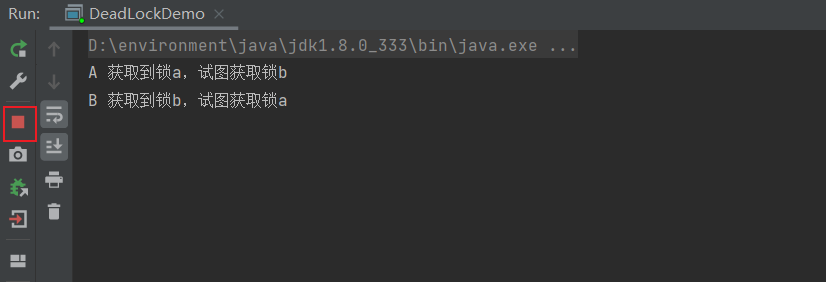
产生死锁的原因:
第一:系统资源不足
第二:进程运行推进顺序不合适
第三:资源分配不当
如何定位死锁,解决问题?
1、使用jps定位进程号,jdk的bin目录下: 有一个jps
命令:jps -l

2、使用jstack 进程进程号 找到死锁信息(jstack是jvm中自带的堆栈跟踪工具)
命令:jstack 进程号
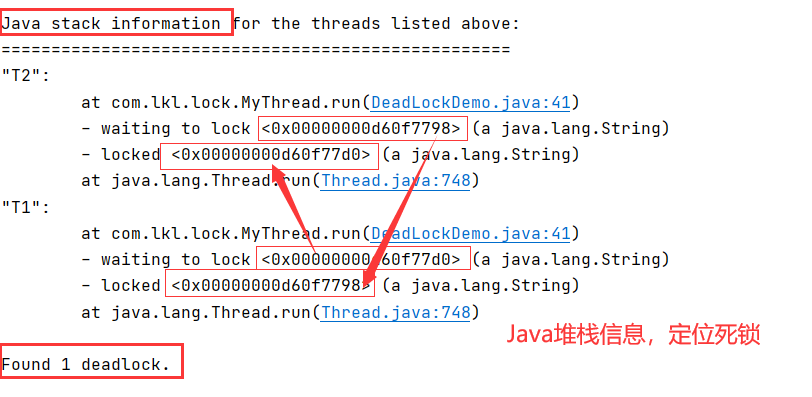
面试,工作中!如何排查问题?
1、日志 90%
2、堆栈信息 10%

